Rugged, remote and wild, Glacier National Park is an incredible place to experience northwestern Montana. We’ve rounded up the top hikes and best things to do in Glacier National Park to help you plan an unforgettable trip!

This article was co-written by Katie (Two Wandering Soles) and Sarah and Matt from Two Outliers.
One of the crown jewels of the continent, Glacier National Park in northwestern Montana is rugged, remote, and wild.
We’ve been to a lot of National Parks across the United States, and Glacier is undoubtedly near the top of our list.
The park includes one million acres of immaculate forest, two mountain ranges, over 700 miles of trails, 131 named lakes, and countless opportunities to make incredible memories.
With a huge range of outdoor adventures, like hiking, backpacking, fishing, boating, and biking, as well as cute nearby towns to explore, foodie experiences, and historic lodges, there’s a little something for everyone in this national park.
In this article, we’re sharing the very best things to in Glacier National Park, from the top sights to the most epic hikes to the unique activities you won’t find in the guidebooks. Plus, we’re sharing all sorts of tips for planning the perfect trip, including some mistakes you’ll want to avoid and ways to beat the crowds.
Glacier National Park Guide
For more tips and advice for planning your trip to Glacier National Park, jump to the following sections (or just keep scrolling to see it all!).
- Park overview
- Areas of Glacier National Park
- Map of Glacier National Park
- Best time to visit
- How to get there
- Entrance fees and tickets
- Getting around in Glacier
- Tips for visiting Glacier
- How to avoid crowds
- Glacier FAQs
- Where to stay
- What to pack
- Round up of things to do in Glacier National Park
Top things to Do in Glacier National Park
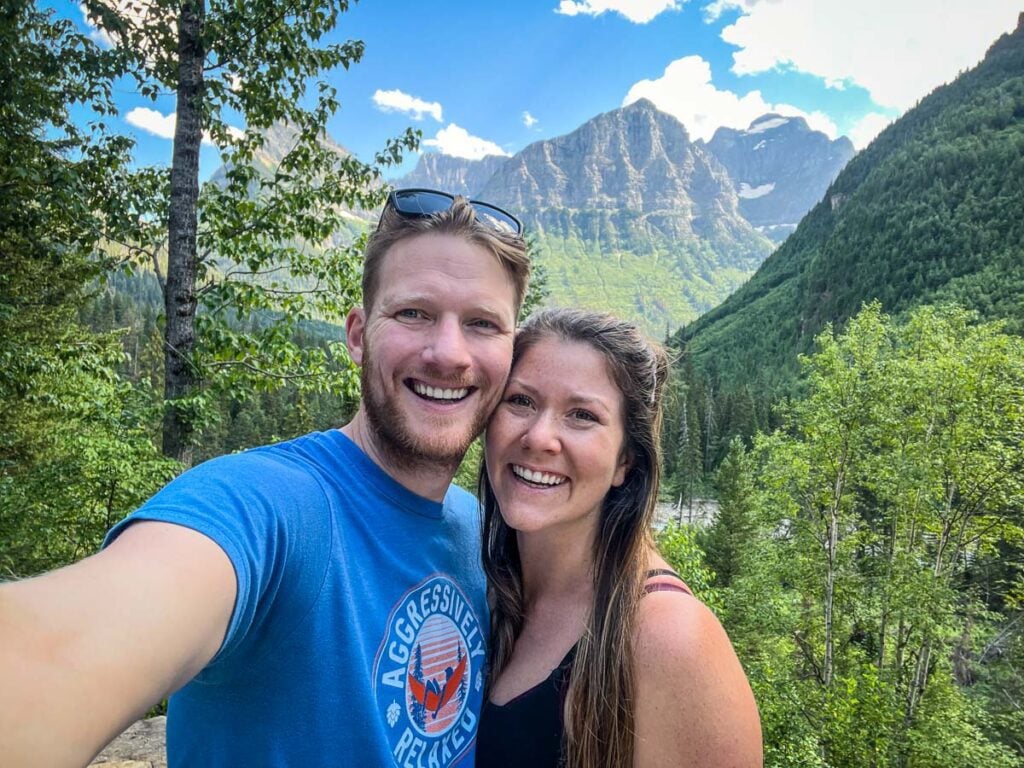
Boredom will not be a consideration as there are so many great things to do in Glacier National Park. If you only have a few days here, you’ll have to pick and choose carefully.
If you’re looking for the very best things to do in Glacier, here are our top recommendations:
- Drive the Going to the Sun Road
- Hit the hiking trails
- Kayak or SUP to a hidden lake
- Go backcountry camping (we loved our overnight at Cracker Lake!)
- Eat huckleberry ice cream
- Step inside one of the park’s historic lodges
Keep reading for more detailed information on each of these things and more ideas of fun things to do in Glacier NP.
1. Drive the Going-to-the-Sun Road
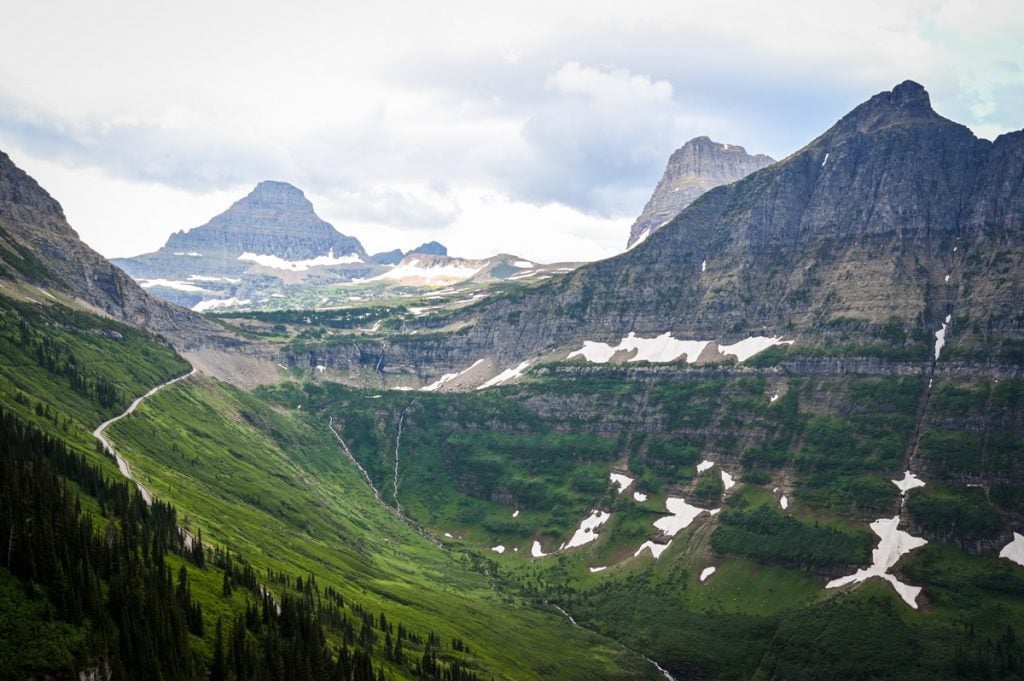
If you only have time for one activity in Glacier, we’d recommend driving the Going-to-the-Sun Road (GTTSR)! This is probably the most popular attraction in the park and allows you to take in everything that makes Glacier so unique.
Starting at West Glacier and ending near St. Mary’s (or vice versa), the winding road bisects the park, running for 51 miles through the mountains, alongside glacial lakes, and hugging sheer cliffs along the Continental Divide.
The lower portion of the GTTSR is open year round but it is closed at higher elevations from mid October through early July due to snow.
Highlights on the Going to the Sun Road
- Logan Pass
- Hidden Lake Overlook
- Highline Trail
- Wild Goose Island viewpoint
- St. Mary’s Falls, Baring Falls, Virginia Falls
How long does it take to drive Going to the Sun Road?
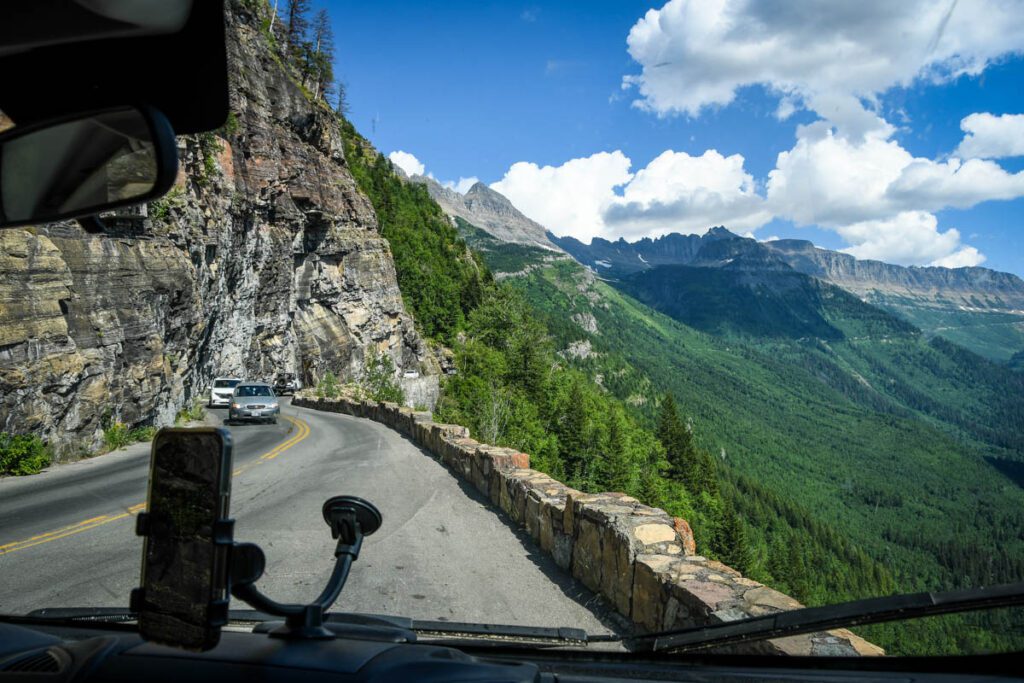
It takes about 2 hours to drive the road one way, plus additional time for stops to take pictures and admire the beauty.
Start your drive early: There is a visitor center at Logan Pass (the highest point on the road), although the parking lot is typically full between 8:30 a.m. and 4 p.m. during the busy season.
Fun facts about Going to the Sun Road
- Going-to-the-Sun Road was a feat of engineering because the engineers and workers faced a huge amount of obstacles, including a very short construction season and sheer cliffs they had to work on.
- After 2 decades of planning and construction, Going-to-the-Sun Road was completed on July 15, 1933.
- Going-to-the-Sun Road was one of the first National Park Service roads specifically intended for tourists in vehicles.
- The highest point on the road is Logan Pass, which sits at an elevation of 6,646 feet.
Entrance tickets for the GTTSR
With its increased popularity, the park now has a timed ticket entry system to drive the GTTSR during peak season. Below you can find more information on GTTSR tickets:
- Vehicles can be a maximum of 21 feet long.
- We drove our campervan (exactly 21 feet long!) on this road, and it was a bit of a white knuckle (albeit stunning) drive. There are tight curves and steep drops, but it is well worth it!
- There is a $2 reservation fee per ticket.
- One ticket is required per vehicle and is good for 3 days.
- Half of all tickets will be made available on March 2nd. The remaining tickets may be reserved on the day before your entrance.
- Tickets are released at 8:00 a.m. MT and typically sell out very quickly.
- In 2023, tickets will be required to drive the GTTSR from July 1st through September 10th.
- If you have reservations at any campground or hotel along the GTTSR, you do not need an entrance ticket for the duration of your stay.
- You can find the most up to date information about the GTTSR ticketing system here.
Psst! Want to combine your trip to Glacier with another incredible U.S. National Park? Check out our Glacier National Park to Yellowstone Itinerary on our sister site to help you plan an epic road trip!
2. Hike the best trails in Glacier National Park

Glacier National Park is a hiker’s paradise. This park covers roughly 1 million acres of land, so you could spend years hiking in this area and still not even scratch the surface.
Glacier is one of our favorite places for hiking in the entire United States, and honestly, just about any hike you do in the park will be fantastic.
Check out our round up of the best hikes in Glacier National Park on our sister site to get some inspiration and help you prepare to hit the trails!
If you want some quick recommendations, here are the top hikes in Glacier National Park along with some of our personal favorites:
Highline Trail
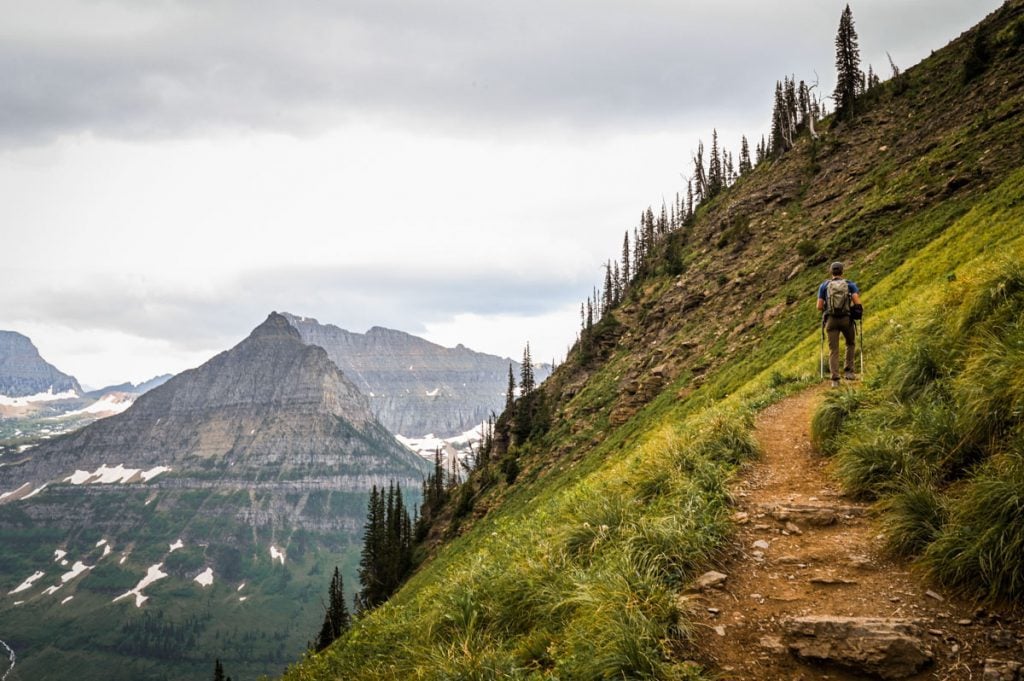
- Distance: 15 miles
- Elevation gain: 2,580 feet
- Type: Out-and-back
- Difficulty: Challenging
- View our trail guide
Hiking the Highline Trail is one of the best things to do in Glacier National Park and easily one of our all-time favorite hikes.
The trail is definitely a challenge, covering 15 miles and 2,580 feet of elevation gain. However, it rewards hikers with spectacular views of the surrounding mountains, colorful wildflowers, and opportunities to see diverse Glacier wildlife.
The Highline trail departs from Logan Pass and follows the Continental Divide, also known as the Garden Wall, providing unobstructed views for nearly the entire hike.
Things to know about the Highline Trail
- Infamous Ledge: About a quarter mile from the trailhead, you will face the infamous ledge, where the trail follows along a 6-8 foot shelf, with a sharp drop off to the left. This section of the trail only lasts for about three-tenths of a mile and there is a handrail installed, but if you are afraid of heights, you might not be a fan.
- I personally have a fear of heights and thought this section was overhyped—it’s really not too scary, so don’t let it deter you!
- Getting to the Grinnell Glacier viewpoint: About 6.5 miles into the trail, you will reach an intersection with a trail that branches up to the right. This spur trail is about 1 mile in length and adds nearly 1,000 feet in elevation gain! Which sounds hard (it is!) but is definitely worth it because it brings you to the top of the Garden Wall ridge with epic views of Grinnell Glacier below!
Cracker Lake
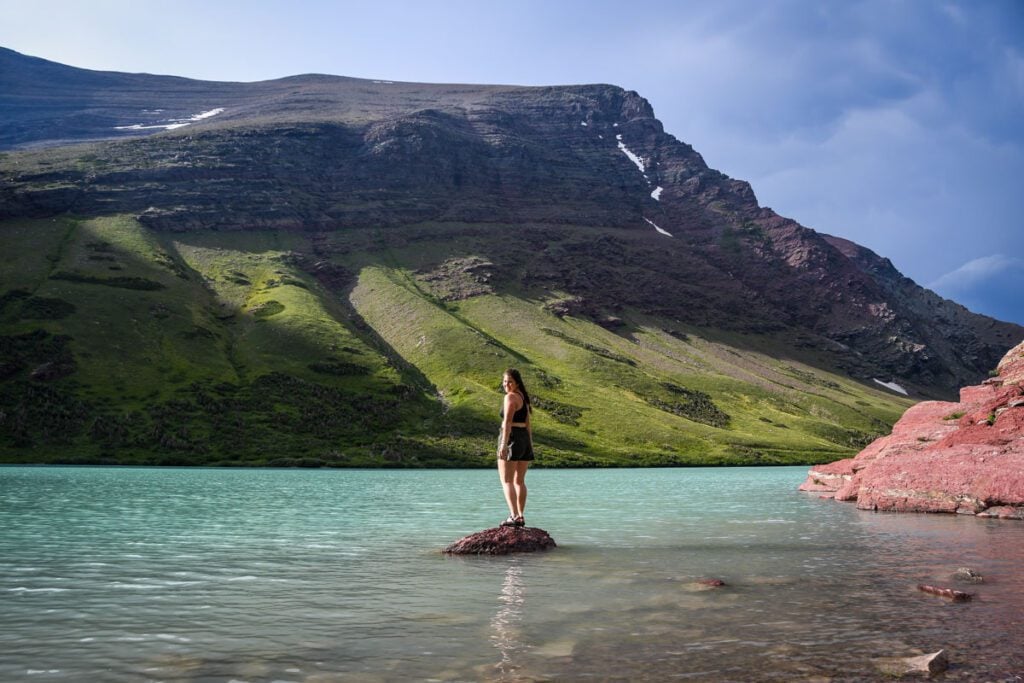
- Distance: 12.6 miles
- Elevation gain: 1,650 feet
- Type: Out-and-back
- Difficulty Rating: Moderate
- View our Cracker Lake hiking guide
This hike starts in the Many Glacier part of the park and was much less crowded than most other trails we experienced. You reward for a moderately challenging 6+-mile hike is a shockingly turquoise lake flanked by snowcapped mountains. Jump in the water to cool down and enjoy lunch with a view!
We brought our daughter, who was 8-months-old at the time, on her second backcountry camping trip here and it was a highlight of our time in Glacier.
Good to know: There are 3 campsites at Cracker Lake, 2 of which can be reserved in advance with one permit available at the ranger station the day before your stay.
Avalanche Lake
- Distance: 5.9 miles
- Elevation gain: 757 feet
- Type: Out-and-back
- Difficulty Rating: moderate
- View the trail notes
This is one of the most popular trails in the National Park and it’s easy to see why. The effort to reward ratio is huge! Hike just under 3 miles (with a pretty reasonable elevation gain) to reach an absolutely stunning lake and glacial views.
Since this is such a popular trail, we’d encourage you to do this one first thing in the morning as the parking will fill up and you’ll find yourself hiking in a line later in the day.
Grinnell Glacier
- Distance: 10 miles
- Elevation gain: 2,047 feet
- Type: Out-and-back
- Difficulty Rating: challenging
- View the trail notes
This is a challenging hike, no doubt about it! If the sheer distance and elevation gain don’t scare you off, you’ll be rewarded with some of the very best views in the park. The last ¼ mile of the trail is the hardest, but your effort will pay off with views of the Grinnell Glacier.
Be sure to wear sun protection as the trail doesn’t have much shade. Bring your bear spray and bug spray too!
St. Mary & Virgina Falls
- Distance: 3.1 miles
- Elevation gain: 452 feet
- Type: Out-and-back
- Difficulty Rating: moderate
- View the trail notes
This hike is one of the easier and shorter ones on this list, and it features 2 waterfalls. This is a popular route, so go early if you want to avoid crowds as much as possible. There isn’t much shade on the trail, so wear sun protection.
Hidden Lake
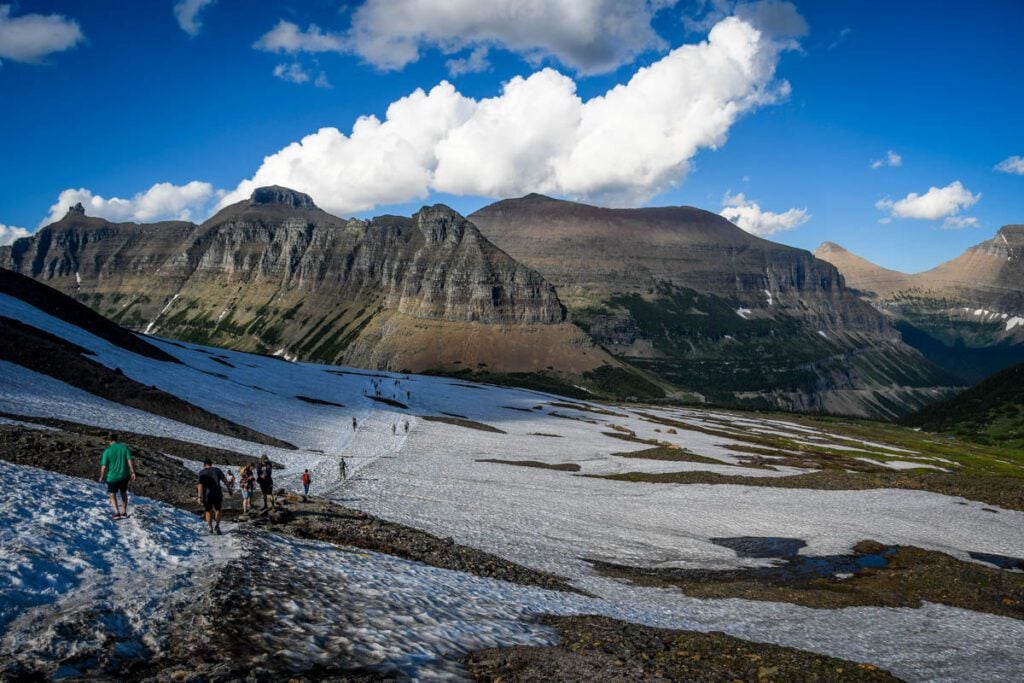
- Distance: 5.1 miles
- Elevation gain: 1,338 feet
- Type: Out-and-back
- Difficulty Rating: moderate
- View the trail notes
The trailhead begins at Logan Pass Visitor Center (the highest point on the GTTSR). Views on this trail are stunning, and herds of big horn sheep are often spotted roaming amongst the wildflowers. The views over Hidden Lake at the end are spectacular.
This is one of the most popular hikes in the park and it can get incredibly crowded. We were there midday and while the views were great, the amount of people made it less enjoyable than the other less-crowded hikes we did (like Cracker Lake). Go early if you want to avoid the crowds.
Good to know: When we hiked this trail at the end of July, much of it was still covered in snow.
Trail of the Cedars
- Distance: .9 miles
- Elevation gain: 49 feet
- Type: Loop
- Difficulty Rating: easy
- View the trail notes
This loop starts at Avalanche Campground and crosses Avalanche Creek in a short and easy walk. At less than a mile long and under 50 feet of elevation gain, this flat trail is family-friendly. The highlight is the view over Avalanche Gorge.
3. Photograph Wild Goose Island
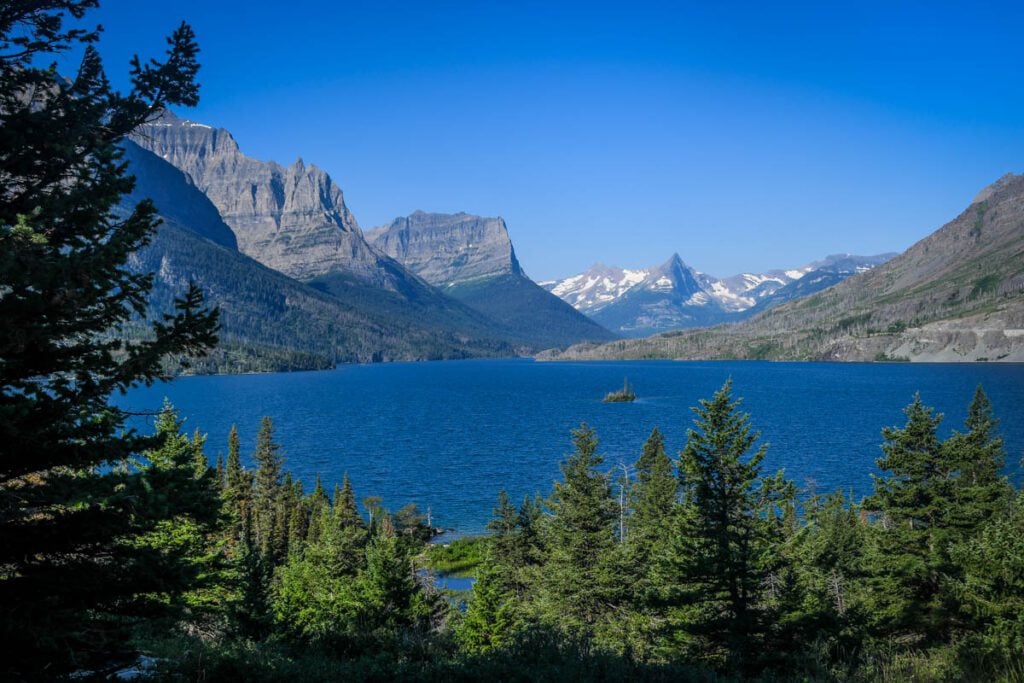
Located just off of the portion of the Going to the Sun Road that hugs Saint Mary Lake, Wild Goose Island is one of the most photographed spots in the National Park and is one of the best quick stops along this drive.
Fun fact: Wild Goose Island was featured in the opening scene of The Shining. See a clip the footage here.
A cluster of trees thrive on this tiny island in the middle of the lake, flanked by mountains, making for a postcard-worthy view. (And yes you actually can buy postcards of this view.)
If you’re an avid photographer, sunrise is known to be the most beautiful time to shoot this scene. But that is an early wake up call (too early for us!), and it is stunning at any time of the day.
Here is the Google Maps location of the viewpoint.
Legend of Wild Good Island
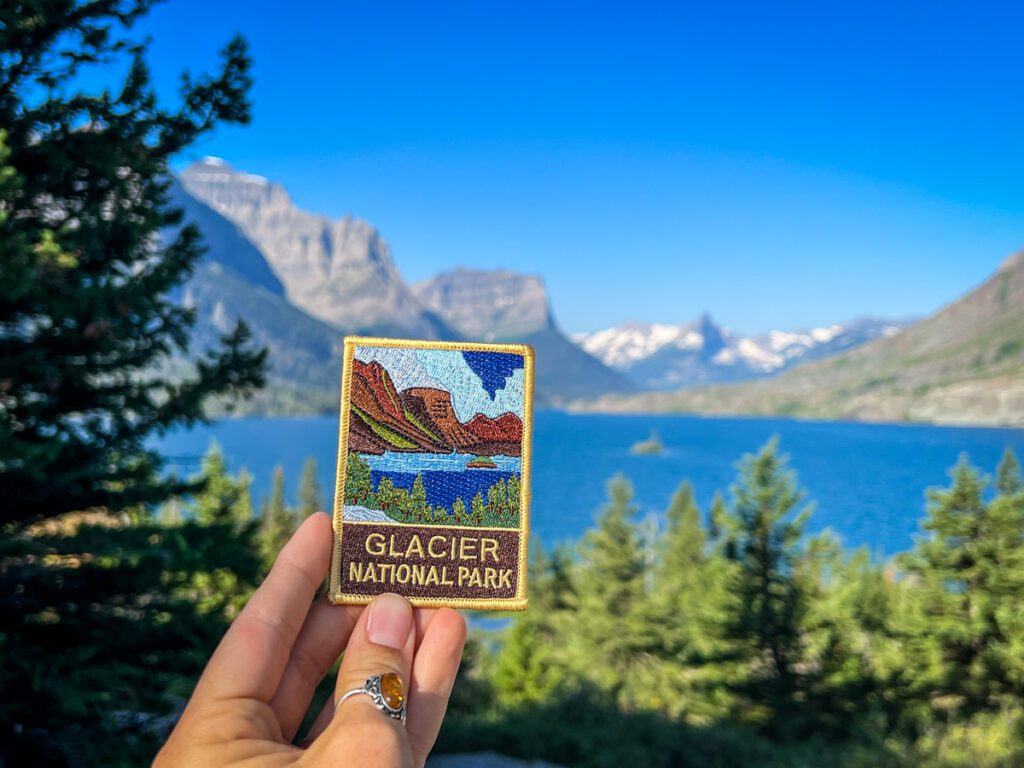
The name of this island has a pretty cool story behind it. I’ll give you the short version…
Many years ago, two Native American tribes lived on opposite sides of St. Mary Lake and rarely interacted. One day, a young warrior saw a beautiful woman from the other tribe swimming to the island, so he jumped in the water and swam to meet her. They instantly clicked and spent the day together, promising to meet on the island the next day.
That evening, elders in each tribe found out about this budding love story and vowed to end it, forbidding them from seeing each other. However, Great Spirit witnessed their love and transformed them into geese.
When the elders arrived on the island, instead of finding the young couple, all they found was 2 geese that when approached stroked their necks together then flew off together into the horizon, never to be seen again.
4. Kayak (or SUP) to a hidden lake

If you want to get on the water in Glacier National Park, you’ll have no shortage of options. However, we think one of the very best water adventures starts at Swiftcurrent Lake. Park at Many Glacier Hotel where you can easily access the lake.
We’d recommend doing this early in the day, as the water tends to be most calm in the morning, giving you glassy reflections of the mountains on the water’s surface.
You can rent kayaks, canoes, and rowboats from the boat rental at Many Glacier (find more info on current rates and reservations here) or your can bring your own.
Good to know: If you’re bringing your own kayak or SUP, you will need to have it inspected for aquatic invasive species. This inspection is free of charge and can be done at numerous ranger stations around the park. Find more info on how to get an inspection here.
Swiftcurrent Lake is stunning to begin with, but for a bit of an adventure, navigate to the creek at the south end of the lake which will bring you to Lake Josephine. This body of water can only be accessed by hiking or on the water, so it feels really special. Just beware that tour boats make this journey each day, so watch out for them.
Speaking of which…
Alternative: Take a boat tour
If you’d rather have a motor do the work for you, it’s possible to take a boat tour through Swiftcurrent Lake and Lake Josephine.
5. Indulge with a huckleberry ice cream cone

Once you get in the Glacier area, you’ll see menus and street signs boasting huckleberry everything — jams, pancakes, ice cream, you name it – try ‘em all!
We’re big ice cream fans, so we stopped by Huckleberry Patch for a cone and a gander through their aisles packed with jams, syrups, fudge, mixes, and gifts. They also boast a killer huckleberry pie (perfect for pairing with a scoop of ice cream!)
What’s the difference between a huckleberry and a blueberry?
Great question — I had the same one! Honestly, they taste very similar, and unless you had them side by side, you probably won’t notice much of a difference. While they are related, the are in fact two different genuses.
Huckleberries have bigger seeds, tend to be more tart, and are not grown commercially. Since they are mostly wild harvested, they are much more rare, so definitely give them a try when you have the chance!
6. Visit Many Glacier

While most visitors tend to stick to West Glacier and St. Mary’s, we recommend getting away from the crowds (as much as that is possible) and spending some time in the Many Glacier area of the park.
Psst! Here are more tips for avoiding crowds in Glacier.
Many Glacier is home to some of the best trails in the park including:
- Cracker Lake (12 miles)
- Grinnell Lake (7.1 miles)
- Grinnell Glacier (11.2 miles)
- Iceberg Lake (9.3 miles)
- Ptarmigan Tunnel (10.5 miles)
If hiking isn’t your jam or if you’re looking for something different to do, you can take a boat tour on Swiftcurrent Lake with Glacier Park Boats. The tour includes 2 boat rides, across Swiftcurrent Lake and Josephine Lake, with a short walk between the 2 lakes. The whole excursion costs $35.25 per adult and $17.50 per child.
7. Go whitewater rafting
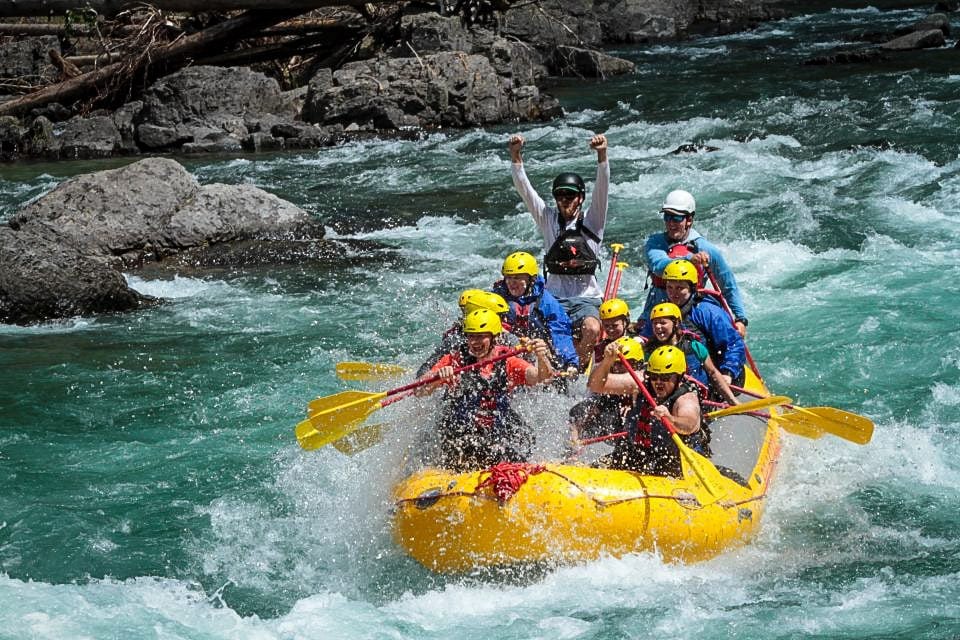
The Flathead River forms the western boundary of Glacier National Park and is a great place to try whitewater rafting, a fun adventure for the whole family!
There are 4 guide companies that have permits from the US Forest Service to run guided trips on the Middle Fork and North Fork of the Flathead River.
All guide services offer full or half day trips that typically run around $80 for a half day and $130 for a full day.
- This is the full-day tour we recommend, and it includes dinner!
- This is a low-key scenic rafting tour that is a good half day adventure for the whole family.
8. Take a dip in a glacial lake
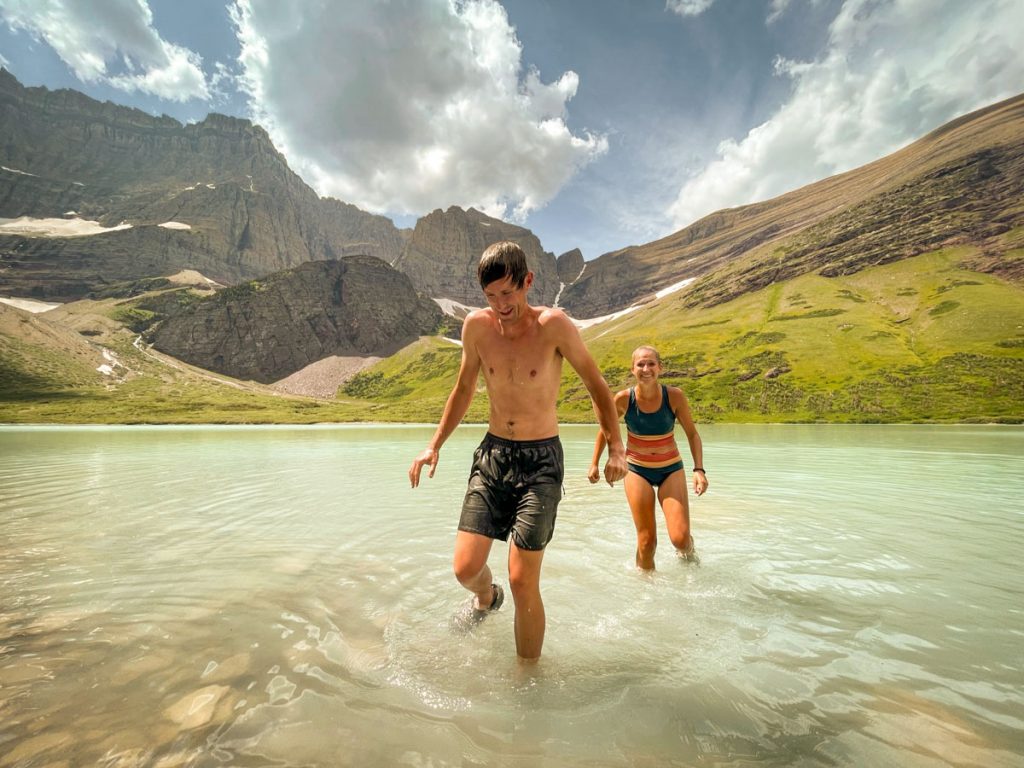
You know that feeling when you reach the end of a long hike on a hot summer day and all you want is a cold drink or something to refresh you? Well, the best way to cool down in Glacier National Park is to take a plunge into an ice cold glacial lake.
You probably won’t last too long as the water will be so cold it quite literally takes your breath away (see our faces in the picture above…)! Nonetheless you will definitely feel refreshed as you scramble out of the frigid waters.
There are many hikes in Glacier that provide a cold alpine lake as your reward, but a few of our favorites include Cracker Lake, Iceberg Lake and Hidden Lake.
9. Spend a night stargazing
Glacier National Park is situated on what’s known as a Dark Sky Reserve. This means there’s a lack of light pollution, making is an excellent spot to view the night sky.
Basically anywhere in Glacier will be a great place for stargazing on a clear night. Lay out a blanket and be prepared to be blown away.
10. Celebrate your trip with a huckleberry cocktail at St. Mary’s Lodge
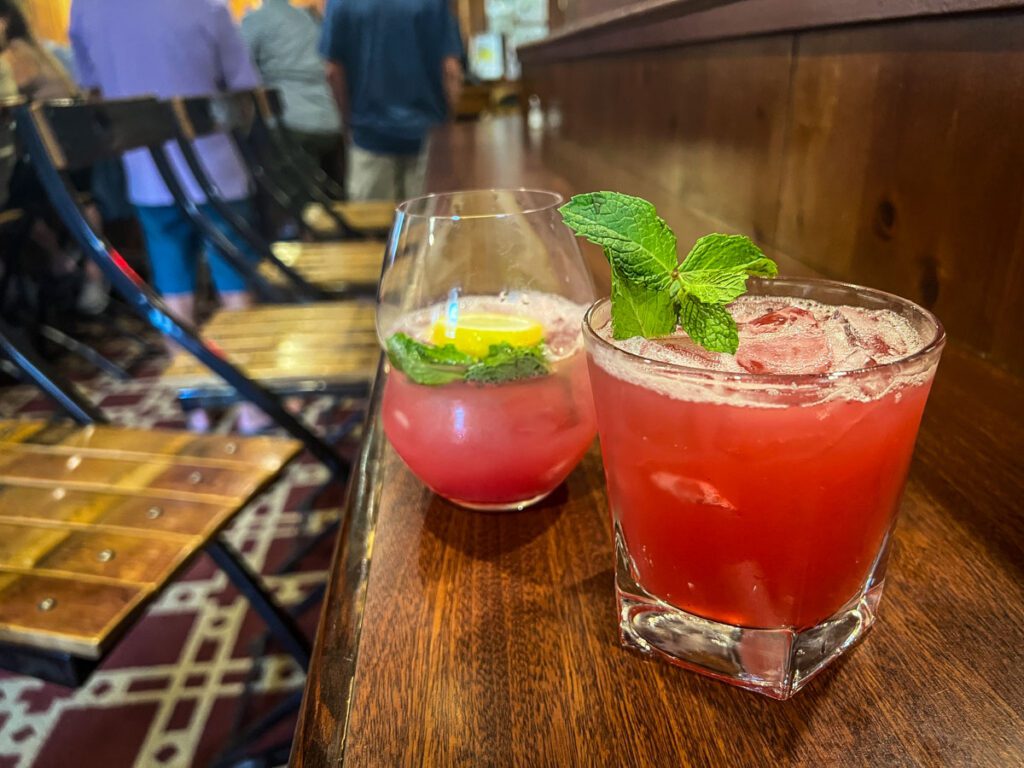
Northwestern Montana is a Mecca for all things huckleberry (like ice cream #5), and yes, cocktails!
The lodge at St. Mary Village is home to both the Snowgoose Grille and the Mountain Bar, each of which serves a large variety of Montana-style huckleberry cocktails.
Choose from a huckleberry margarita, huckleberry lemon drop, huckleberry gin rickey, huckleberry mule, or a spiked huckleberry lemonade… I kind of felt like Bubba Gump listing off all those choices! But the point is, there’d a huckleberry drink for everyone! (You could probably ask for a non-alcoholic huckleberry lemonade too.)
The main dishes at the Snowgoose Grille are overpriced for the quality (in our opinion), but it can be a nice place for an appetizer and a huckleberry drink to celebrate an epic day of adventuring!
Our advice: Personally, we’d recommend going to the Mountain Bar where you can enjoy your drinks there or take them to the deck to enjoy with a view.
11. Spot wildlife (from a distance!)
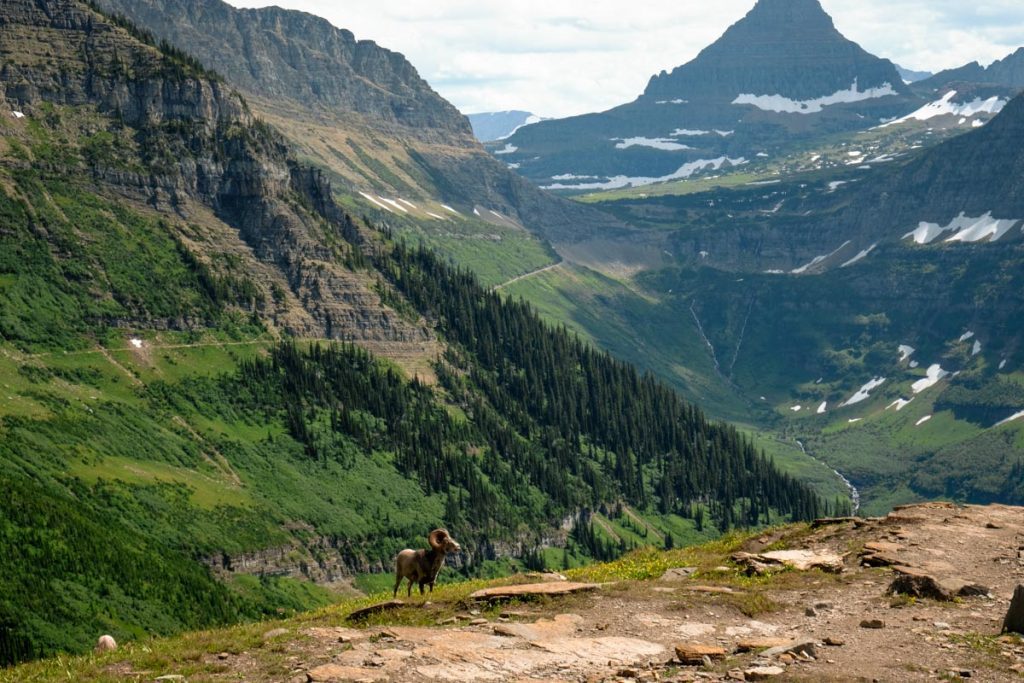
Glacier National Park is one of the largest intact ecosystems in the lower 48 and is home to an incredible diversity of wildlife.
Some of the animals you can find in Glacier National Park include:
- mountain goats
- bighorn sheep
- elk
- grizzly bears
- moose
- marmots
- pikas
- birds
If you spend any amount of time on the trails, you are likely to encounter some wildlife which will surely be a highlight of your visit.
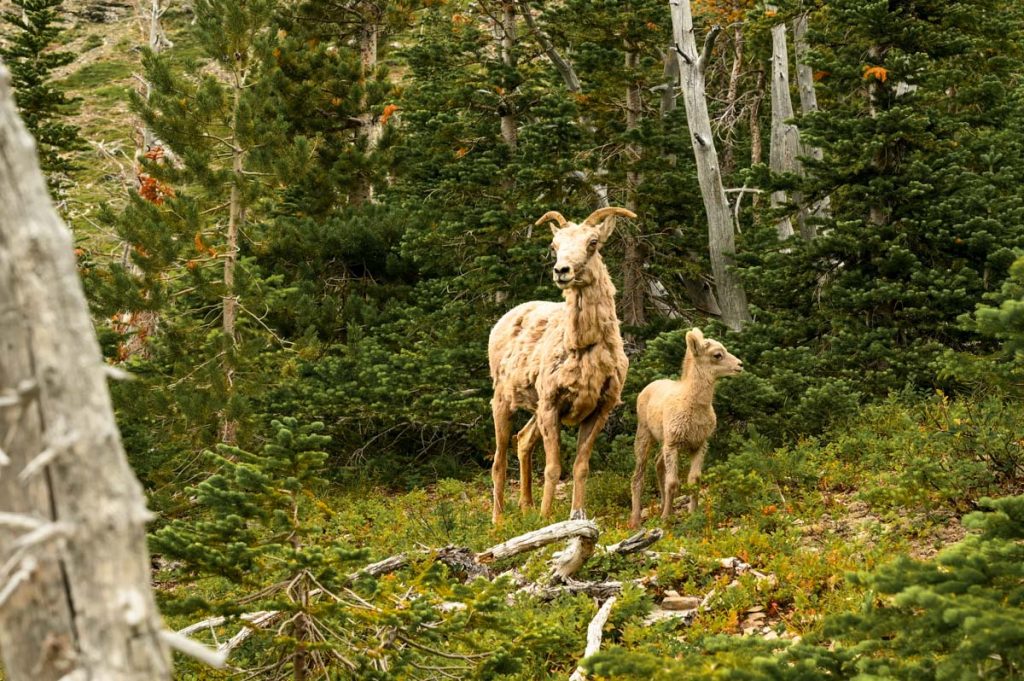


We once got stuck waiting on a trail because a very grouchy mountain goat was blocking the way and was not happy with the noisy hikers disturbing his lunch! One morning we woke up to the sound of two moose ruffling around the shrubs near our tent at Cracker Lake.
We even had the pleasure of seeing a grizzly bear (from afar!) which isn’t an uncommon sight since Glacier is home to one of the largest grizzly populations in the lower 48. This is why it’s incredibly important to carry bear spray on you during all hikes.
Important Note: You should always maintain a respectful and safe distance from all wildlife. The park asks visitors to maintain a distance of at least 100 yards from bears and 25 yards from any other wildlife. To make it simpler, if the animal notices you or changes their behavior because of you, you are too close!
12. Catch sunrise (or sunset!) at Two Medicine Lake

While Glacier is beautiful during the day, it is even prettier in the soft morning light as the sun rises above the mountains and lakes.
There are plenty of spots throughout the park to see an epic sunrise, but one of our favorites is from the banks of Two Medicine Lake. Just check out the picture above to see why.
If you’re not a morning person, don’t worry – sunset is also stunning.
13. Go on a backpacking trip
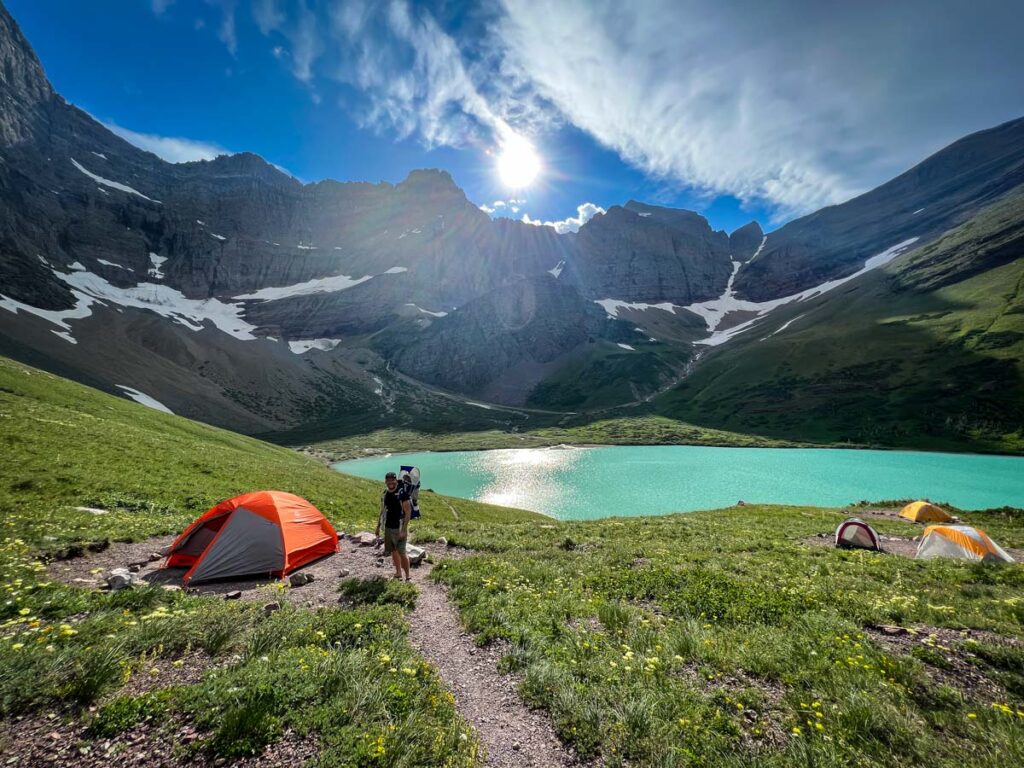
A true Glacier experience is not complete without at least one night under the stars in the rugged and remote backcountry! It is one of the very best ways to escape the crowds. Trust it!
We had the BEST time spending the night at Cracker Lake with the area completely to ourselves (as well as 2 other groups that were camping).
There are tons of backpacking options in Glacier but a few great routes include:
- Cracker Lake: 12 miles, 1,650 feet elevation gain (see photo above!)
- Dawson Pass and Pitamakan Pass: 18.8 miles, 3,800 feet elevation gain
- Gunsight Pass: 19.3 miles, 3,300 feet elevation gain
- Boulder Pass Trail: 29 miles, 4,600 feet elevation gain
We found this backcountry map super helpful for planning our backpacking trips in Glacier.

Permits are required for backcountry camping and 70% of all backcountry sites are available for reservation in advance, while the remaining 30% are available as walk up permits starting the day before the start of your trip. Reservations are made available via a lottery system in mid-March for the entire season. Backcountry campsites are $7 per night, and there is also a $40 reservation fee (not charged for walk up permits).
Each backcountry site has an “earliest reservable” date based on weather conditions, which can be later in the season than you’d expect due to lingering snow. Find more info about booking advance reservations here.
Psst! Check out our beginner’s guide to backpacking on our sister site for some helpful tips!
14. See the colorful pebbles at Lake McDonald
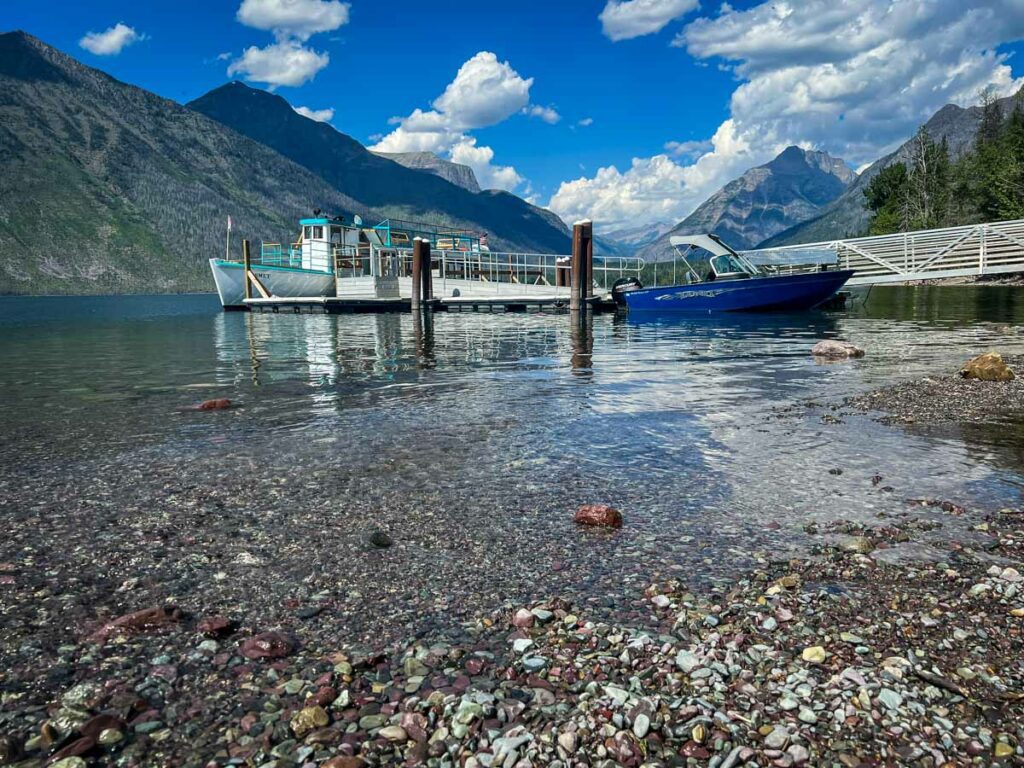
You may have seen photographs of rainbow-hued rocks beneath shallow waters in Glacier. Those shots are mostly taken from the shores of Lake McDonald.

While people sometimes edit their photos to make the rocks even brighter than they are in real life, they are still a sight to behold.
15. Take a Red Bus Tour

You don’t have to be in the park long before you start to notice the iconic Glacier “red buses”. They’re more like long cars than buses, and are a great way to see a good chunk of the park in a short amount of time.
Good to know: This is also a great option if you are traveling in a campervan or RV that is longer than the maximum 21 feet that can access the Going to the Sun Road.
The vintage fleet of 1930’s vehicles are said to be the oldest fleet of tour vehicles anywhere in the world.
The driver-slash-guide will share about the park’s history along the scenic drive through Glacier National Park, including some of the top sights.
Good to know:
- The red bus tours depart from both the east and west sides of the park and tours are all round trip.
- Red buses seat 16 people spread out on 4 benches, making for a tight squeeze.
- Book your red bus tour in advance because they sell out every day.
16. See a glacier in Glacier
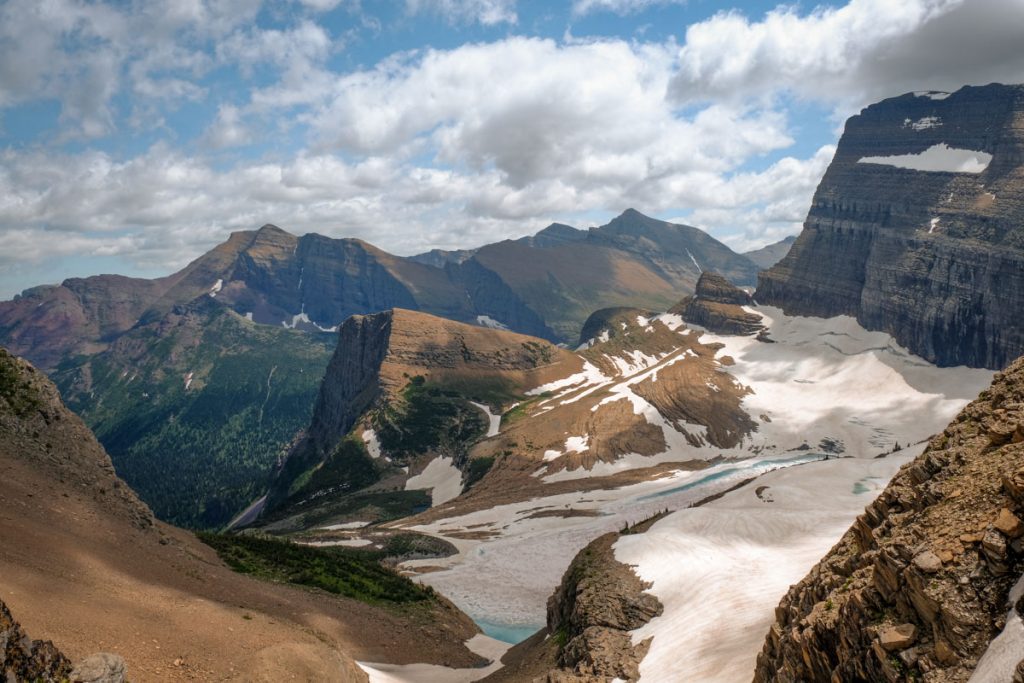
Glaciers aren’t as easy to find as you’d expect in a park named after them! There are 25 glaciers in the park and most are located deep in the backcountry. Ironically, North Cascades National Park has the highest concentration of glaciers in the lower 48, with over 300!
Nonetheless, seeing a glacier in Glacier just feels right (when in Rome…as they say). One of the most popular glaciers in the park is Grinnell Glacier which can be reached via an 11.2 mile hike.
The trail climbs just about 2,200 feet and takes you through some of the most beautiful sights the park has to offer. You can also see the Sperry Glacier from the Hidden Lake Overlook Trail, which is a more reasonable 2.9 miles.
If you aren’t in the mood for a hike, you can see the Salamander Glacier from the drive into Many Glacier or the Jackson Glacier on the GTTSR.
Fun fact: A glacier is a large chunk or area of snow that has slowly compressed to form ice over many, many years. A distinguishing characteristic of glaciers is their ability to flow or slowly move, carving the surrounding landscape. Glaciers can be just a few hundred meters long or a few hundred kilometers. When visiting Glacier National Park, try to imagine the ways in which moving glaciers have shaped the mountains and valleys.
17. Step inside Glacier’s historic lodges

While the park is rightfully known best for its stunning scenery, pristine lakes, rocky mountain peaks, vibrant alpine meadows, and diverse wildlife, the man-made history of the park is interesting as well.
Not long after becoming a National Park in 1910, Glacier was nicknamed “America’s Switzerland”. Following suit, the park’s lodges were built in a Swiss-style, boasting features like gabled roofs, ornate decorative moldings, exposed beams, balconies, and several large windows.
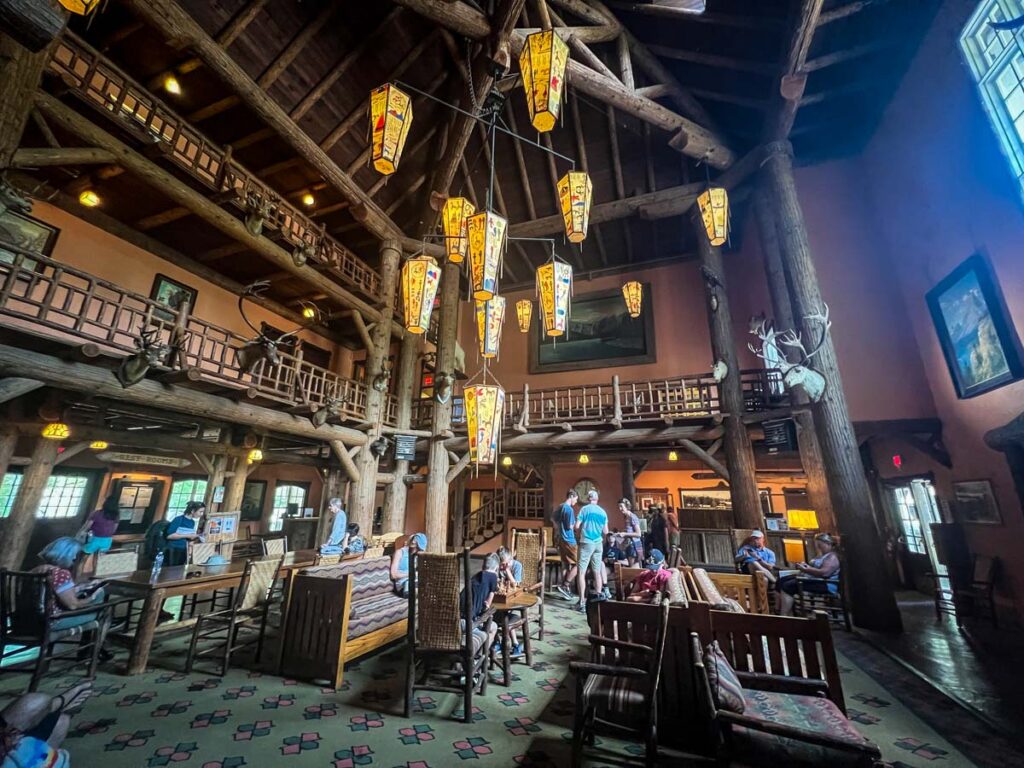
Today, you can stay in the lodges or simply walk through the public areas.
The lodges have restaurants and bars, so even if you’re not staying you can grab a bite to eat in a a building that is more than 100 years old.

- Glacier Park Lodge (built in 1912 – 1913)
- Lake McDonald Lodge (built in 1913 – 1914)
- Many Glacier Hotel (built in 1914 – 1915)
Not gonna lie, some of them could use a little TLC to fix the peeling wallpaper and give the tired carpeting a facelift. But they are still cool to see nonetheless!
18. Hop across the border to Waterton Lake National Park

Waterton Lake is a long and narrow lake that sits on the US-Canada border and crosses into each side.
On the Montana side, Waterton Lake is in the remote and seldom-visited part of the park called Goat Haunt. Across the border in the Canadian side, this body of water is part of Alberta’s Waterton Lakes National Park, which is a less-crowded version of its American neighbor.
Waterton Lakes combined with Glacier National Park, forms the Waterton-Glacier International Peace Park.
You can take a day trip to Waterton Lakes or spend a few days there.
Things to do in Waterton Lakes National Park:
- take a guided boat tour
- go hiking or biking
- enjoy high tea at the Prince of Wales Hotel
- explore the town of Waterton
19. Go fly fishing
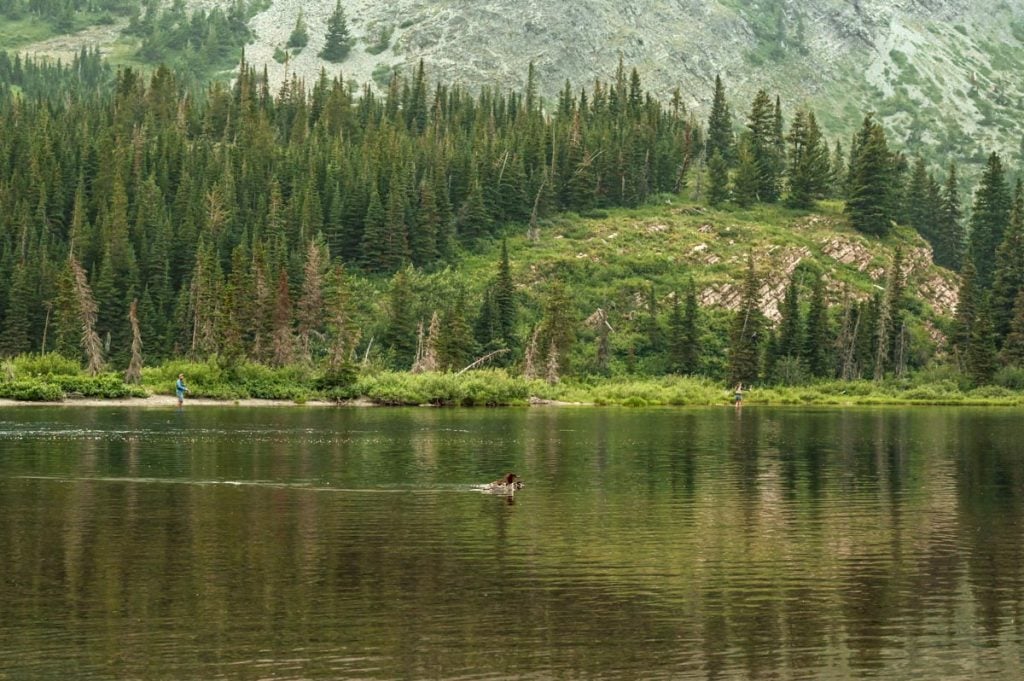
Glacier National Park is home to world-class fly-fishing and is a great place to release your inner angler! Some of the best places in the area to fly fish are:
- Flathead River
- St. Mary River
- Belly River
- Two Medicine Creek + Pray Lake
If you’d prefer to join a guided adventure, Glacier Guides offers fly fishing trips, from half day to overnight trips. The prices are $490 for 2 people for half day, $650 for 2 people for full day, and $1350 for 2 people for a 2-3 day trip.
If you’d like some casting help so you feel more confident going out on your own, this fly fishing lesson is a great option.
Note that certain areas of the park are closed to fishing to preserve aquatic species. See the full list here.
20. Explore the park on horseback

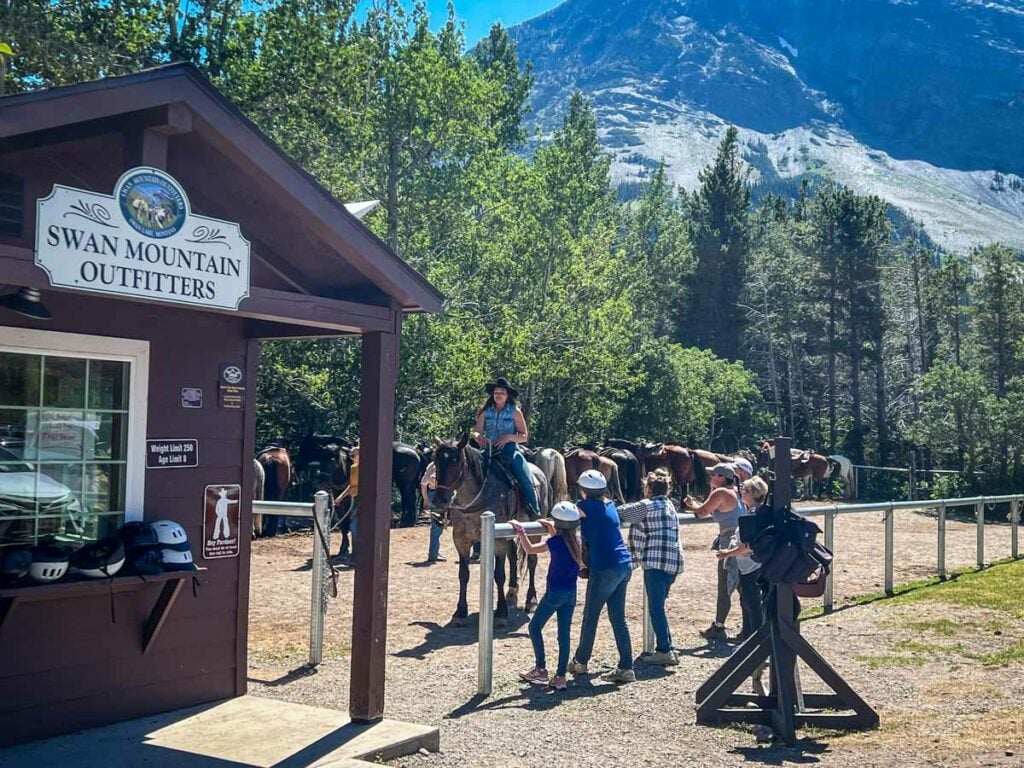
As the original means of transportation in the park, horseback riding has a long history in Glacier.
Swan Mountain Outfitters is the only tour company offering rides inside the park. They operate tours in three areas – Apgar, Lake MacDonald and Many Glacier. They also offer tours just outside the park in West Glacier.
Rides are $60 for 1 hour, $90 for 2 hours, $150 for half day and $225 for full day.
21. Spend a night at Granite Park Chalet
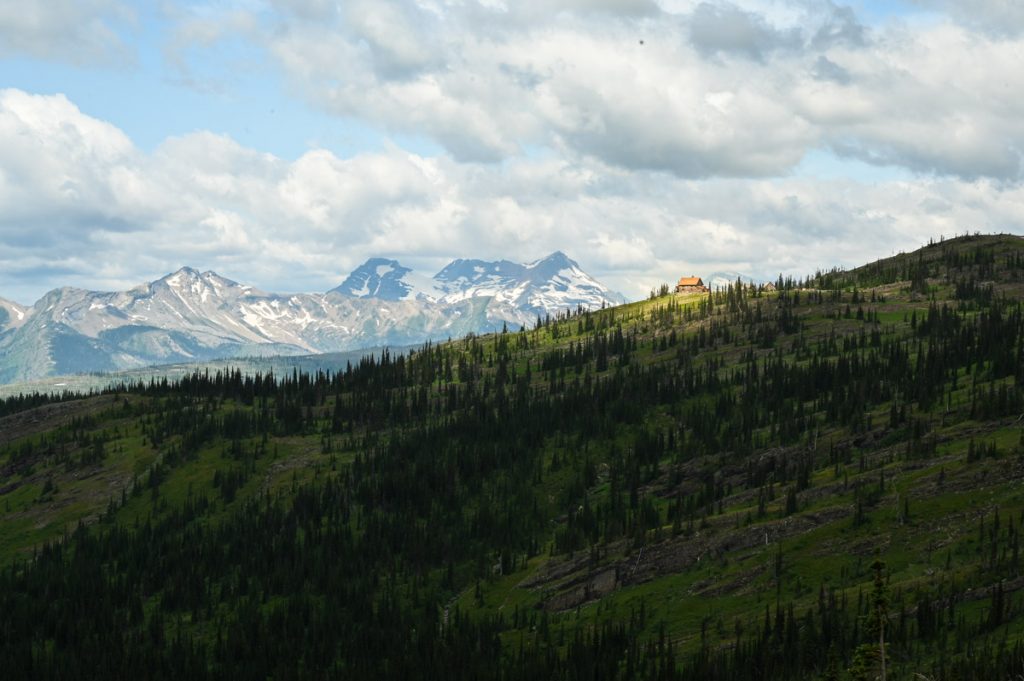
If you’re interested in spending a night in the Glacier backcountry, but you’re not up for camping in grizzly territory… you’re in luck!
The Granite Park Chalet is a rustic cabin perched high in the mountains and deep in the backcountry. Staying at the chalet is like backpacking without the tent, plus a few extra amenities.
You will hike in, bring a sleeping bag, and cook your own meals. However, there is a full kitchen for your use, a snack bar selling packaged food and water, and linen service available for an additional $25 fee.
Granite Park Chalet is open from late June through early September and nightly rates run $124 for the first person in a room and $85 for each additional person. Reservations for the season are made available starting in January each year, and book up quickly.
To get to Granite Park Chalet, there are several possible trails you can hike. The Highline Trail is by far the most popular option, but the chalet can also be reached via the Loop Trail (4.2 miles, 2,200 feet elevation), or Swiftcurrent Pass (7.6 miles, 2,200 feet elevation)
Reservations for Granite Park chalet can be made here
22. Enjoy some “beach” time
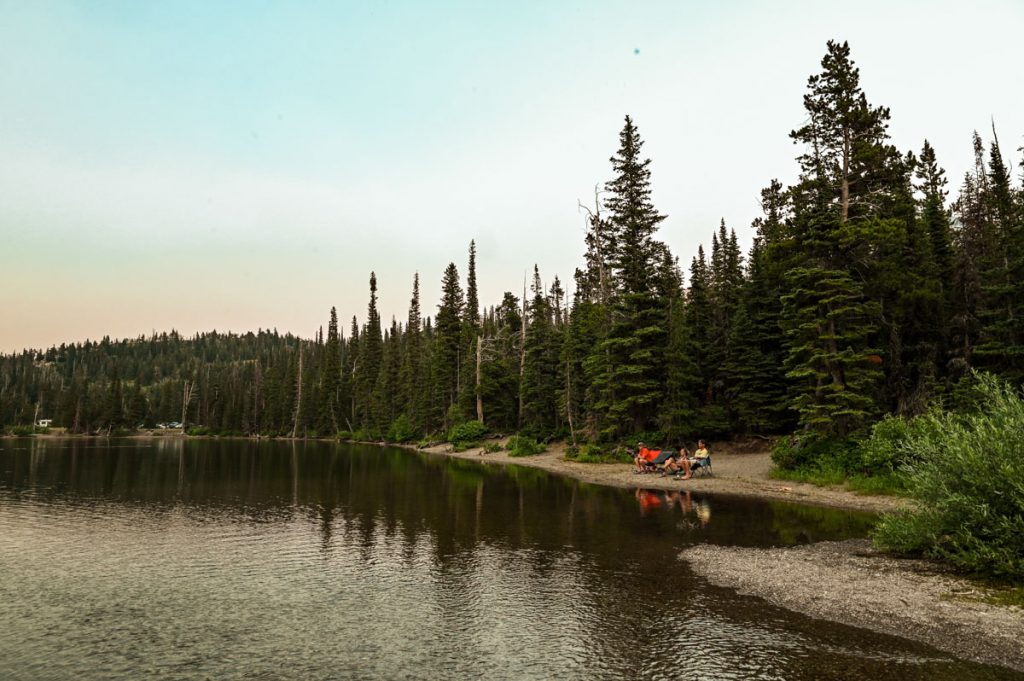
Did you know there are approximately 700 lakes in Glacier National Park? Of the 700 lakes, only 131 are named!
If you have tired yourself out from hiking and exploring the park, grab a chair, crack a beer, and set yourself up for a relaxing afternoon with your toes in the water of one of Glacier’s many lakes.
Some of the most popular and accessible lakes are Lake MacDonald, St. Mary Lake, Two Medicine Lake, Swiftcurrent Lake, and Lake Josephine.
23. Go glamping

If a hotel or lodge stay sounds too boring for you but camping is a little too rustic for your taste, we’ve got the perfect compromise (Goldilocks style!)…
Try glamping!
There are many places near Glacier National Park that you can experience this more elevated and luxurious take on camping. Here are some of our top recommendations:
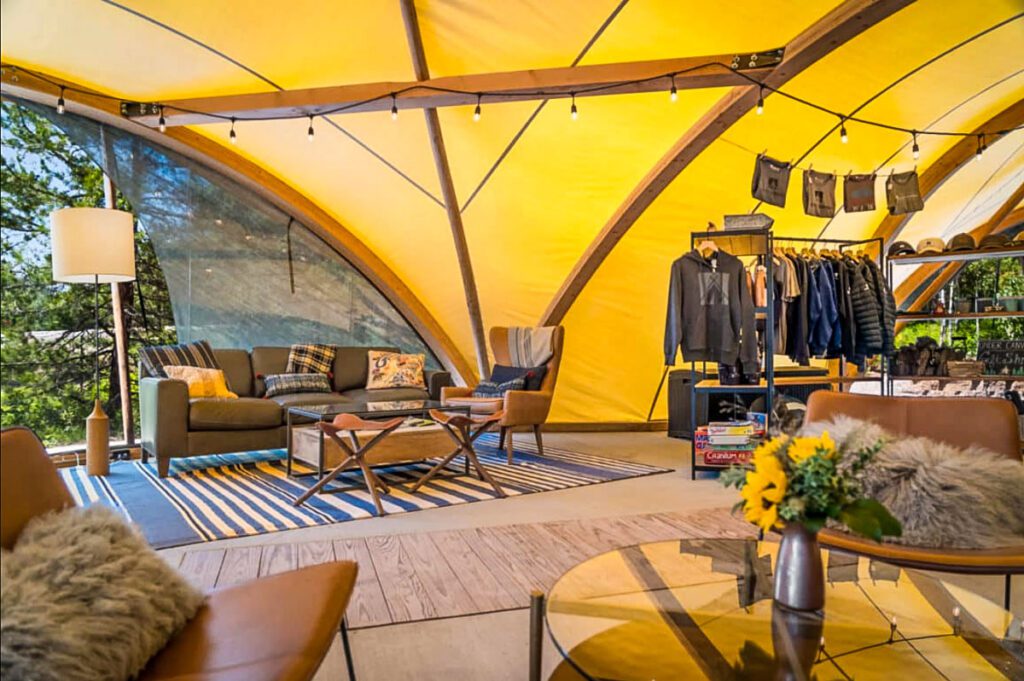
UnderCanvas (our top pick!)
This is a nationwide glamping “brand” of sorts that has locations at several National Parks throughout the US, Glacier being one of them.
They have a variety of different types of gaming tents as well as free activities, like yoga and live music, as well as a communal fire pit where you can roast complimentary s’mores each night.
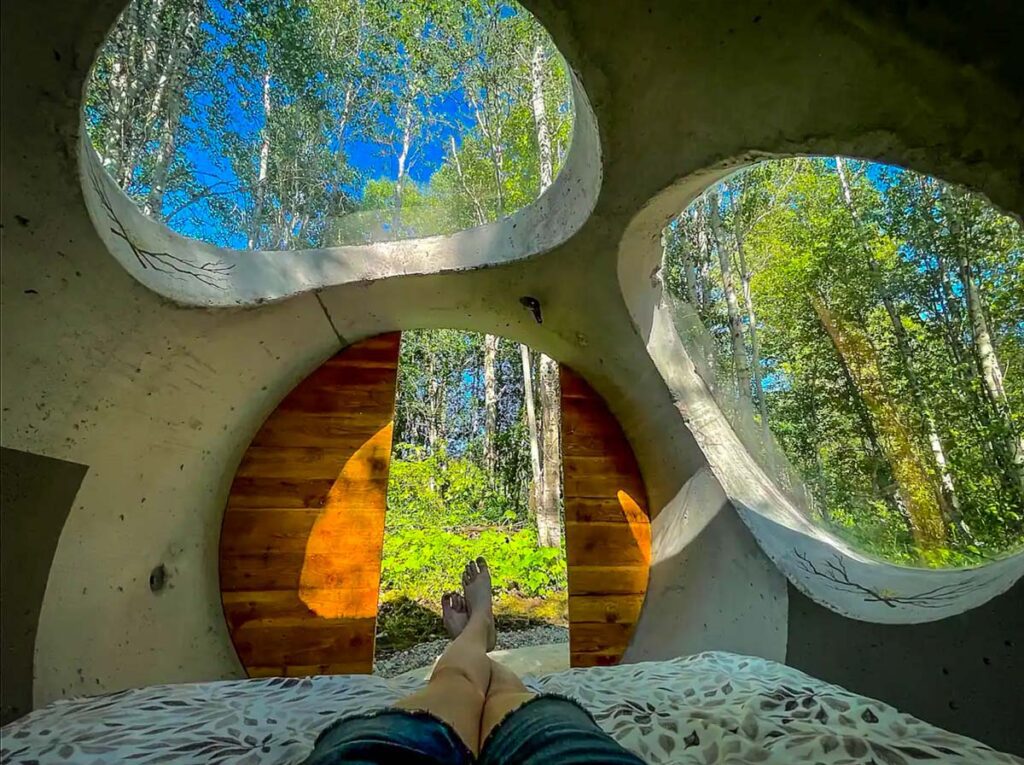
Stargazer Tube Tent
This tube-style “hobbit home” is one of the most unique places to stay near Glacier National Park.
Constructed with skylights above the bed, this cozy cylindrical pod is located in the Montana wilderness, making it a great place to stargaze. This is a great choice for couples looking for something different.
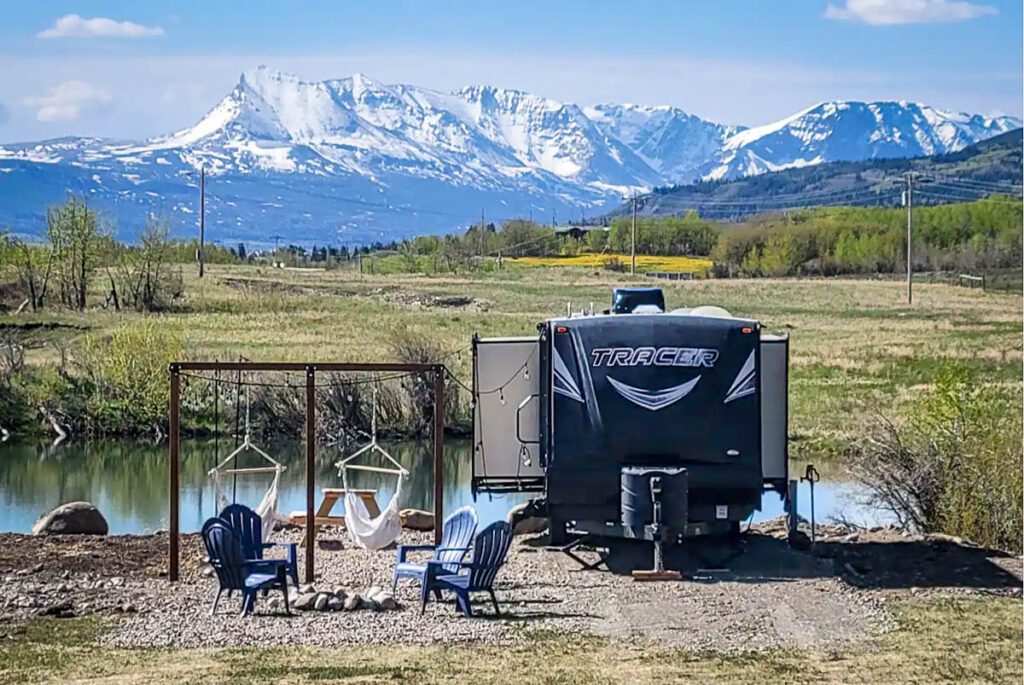
Glacier Bay Campsite
If you’ve ever wanted to try out RV life, this is your chance! This fully-stocked RV is situated on a beautiful piece of land just outside the National Park. Enjoy peaceful mountain views, your own private fire pit, and hammock chairs from your homebase.
Personal note: We’d love to see this host update the interior of this RV with a little bit of a creative flair, but even though it’s pretty basic inside, it earns great reviews, is well-located, and is rated as being very clean.
Not finding what you want? Check out this section where we highlight some cozy cabins and other excellent places to stay near Glacier.
24. Visit Whitefish, Montana
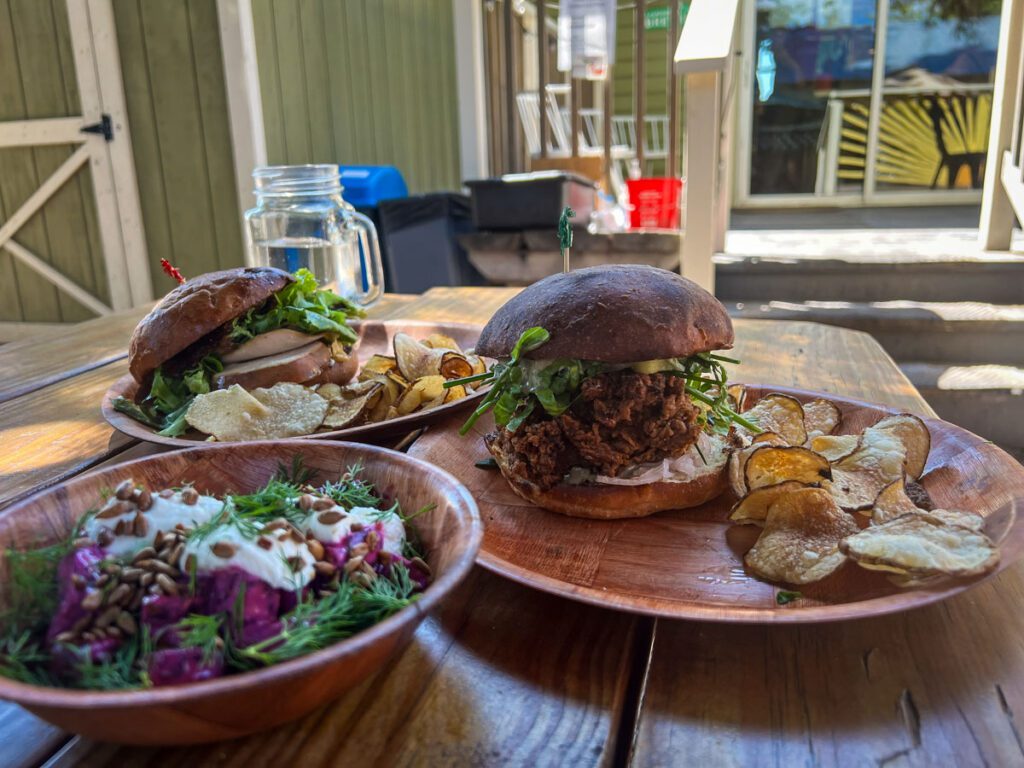
Whitefish is the closest town to Glacier and the most popular “home base” for many visitors to the area.
Luckily, this cute, historic town in western Montana offers plenty of great things to do! The list below includes just a few highlights of the area:
- Whitefish Mountain Resort: One of the most popular ski resorts in Montana, Whitefish Mountain Ski Resort provides access to over 100 ski routes during the winter, as well as hiking, mountain biking, and zip-lining during the summer.
- Whitefish City Beach: This sandy beach is located on the southern end of Whitefish Lake, close to downtown. During the summer, you can rent kayaks and paddleboards.
- Downtown: You can easily spend a morning or afternoon strolling through downtown Whitefish, coffee in hand, popping into the many local shops and galleries.
- Flathead Lake: About 30 minutes south of Whitefish, Flathead Lake is the largest freshwater lake west of the Mississippi in the lower 48. It’s actually one of the largest lakes in the country besides the Great Lakes, the Great Salt Lake, and lakes in Alaska. It is also one of the cleanest lakes in the world and is situated in the Flathead Valley, making it a great day trip from Whitefish.
- Big Sky Brews Cruise: The only thing better than going to one brewery is having someone else drive you to multiple breweries! Big Sky Brews Cruise is a super fun way to visit many of the area’s local breweries or you can add a stop at a winery or distillery.
Where to eat in Whitefish, Montana
Additionally, Whitefish has plenty of restaurants, from ice cream and crepes to special-occasion spots:
- Cafe Kandahar: Located at Whitefish Mountain Resort, Cafe Kandahar has racked up plenty of local and national attention and accolades.
- Amazing Crepes: A fun spot located right in downtown, Amazing Crepes serves up, you guessed it, amazing crepes!
- Tupelo Grille: Southern comfort food with a fun, western twist!
- Sweet Peaks Ice Cream: Who doesn’t love some ice cream?
- The Buffalo Cafe: A local institution since 1979, the Buffalo Cafe is known for typical western fare in a laid-back environment.
25. Cheers with a local brew

If you’re a craft beer lover (like us!), you’ll want to make sure you stop by Bonsai Brewing Project in Whitefish.
With a dog-friendly outdoor beer garden as well as a variety of food options — think creative sandwiches, fancied-up hot dogs, rice bowls, and salads — this makes a great place to refuel after a hike or to celebrate an epic trip to Glacier NP!
Glacier National Park overview
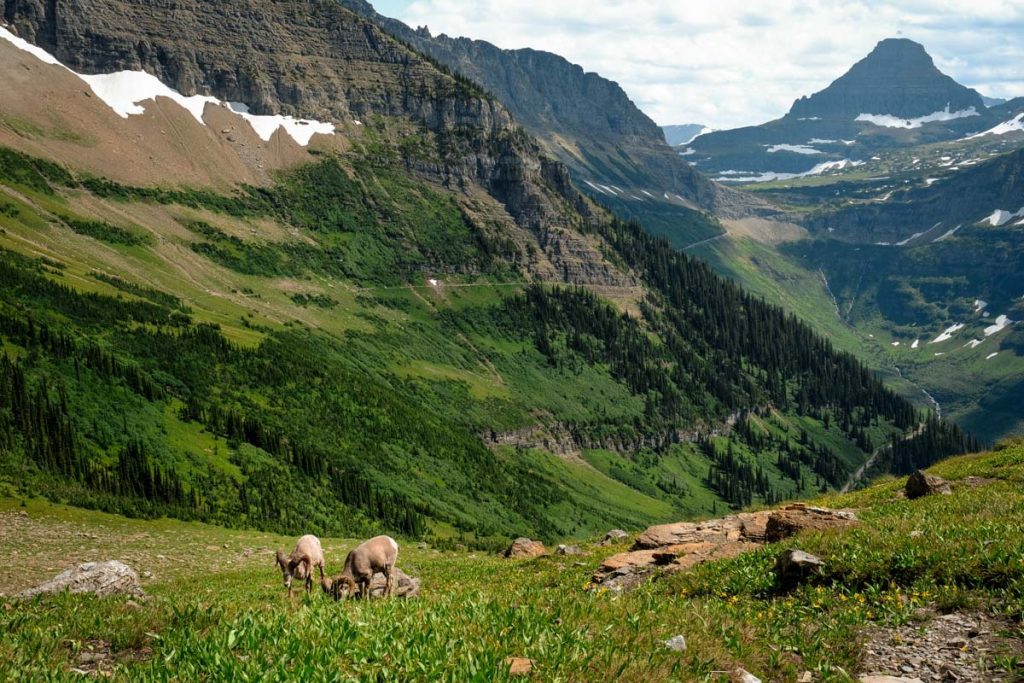
Before we dive into the best things to do in Glacier, here are some things you should know about this National Park.
- Glacier was designated as a National Park in 1910.
- Archeological evidence suggests that Native American tribes inhabited the area as many as 10,000 years ago. And the mountain ranges that dominate the landscape began forming over 170 million years ago.
- Today, the park welcomes over 3 million visitors annually.
- After being designated as a national park, the National Park Service undertook a campaign to construct numerous chalets and hotels throughout the park designed to portray the area as “America’s Switzerland.” Many of these lodging options remain in place today and an incredible 350 structures within the park are registered on the National Register of Historic Places.
- Glacier National Park is aptly named, as it is home to 25 different glaciers. That being said, at its peak in the mid-19th century, there were an estimated 150 glaciers in the area. Scientists have estimated that all glaciers in the park could melt by 2030, which should be reason enough not to hesitate if you are planning a trip.
Areas of Glacier National Park
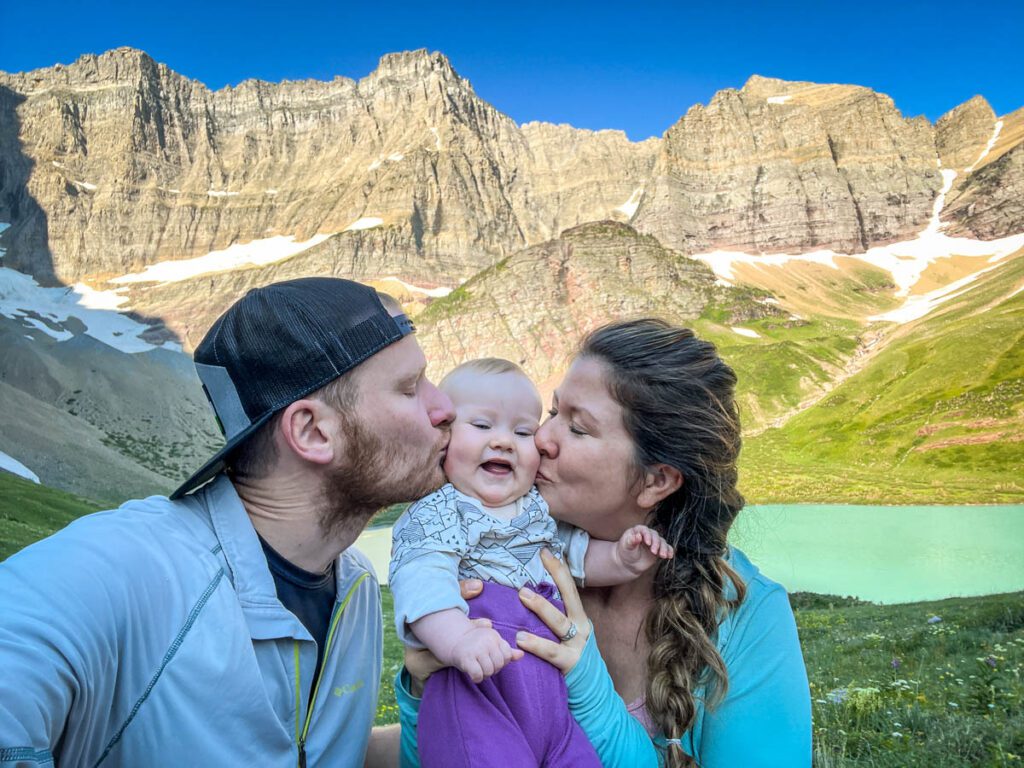
Glacier National Park is enormous, with several distinct sections to explore.
You’ll definitely want to take a moment to orient yourself because driving from one side of the park to the other can take hours.
Insider Tip: Before your trip, be sure you know which side of the park you plan to enter at. Also, make a list of the things you want to do in each section of the park so you don’t miss them. Once you leave an area, it can take a long time to backtrack.
Below is a brief summary of each area of the park:
St. Mary’s
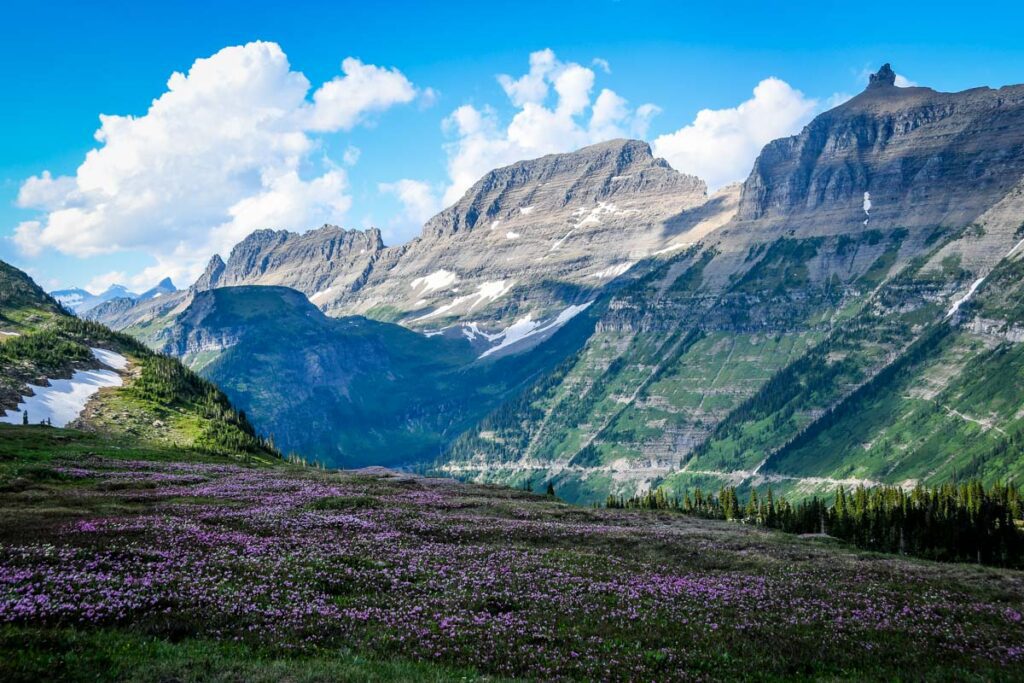
The most popular area of the park, St. Mary’s is located on the eastern side of Glacier and includes one of the entrances to the iconic Going-to-the-Sun Road (GTTSR). Logan Pass, the highest elevation reachable by car in the park (6,646 ft) is located within St. Mary’s.
Highlights of St. Mary’s:
- Start of the GTTSR
- St. Mary Lake
- Wild Goose Island viewpoint
- St. Mary’s Falls, Baring Falls, Virginia Falls
West Glacier/Lake McDonald
West Glacier is the main entrance to the park and includes the other start/end point of the Going to the Sun Road (GTTSR), as well as the picturesque Lake McDonald. This is also where you’ll find the Apgar Visitors Center.
Highlights of West Glacier:
- Lake McDonald
- Trail of the Cedars
- Lake McDonald Lodge
- Avalanche Lake hike
Many Glacier
Many Glacier is located on the eastern side of the park and is definitely less visited than West Glacier and St. Mary, but is still a fairly popular hiking location.
Highlights of Many Glacier:
- Grinnell Glacier hike
- Cracker Lake trail
- Swiftcurrent Lake
- Lake Josephine
Two Medicine
Located at the southeastern tip of the park and is more remote than the previously mentioned areas is Two Medicine. However, it’s growing in popularity as other sections of the park become overcrowded.
Highlights of Two Medicine:
- Upper Two Medicine Lake
- Pitamakan Pass
- Running Eagle Falls
- Appistoki Falls
North Fork
Located in the northwestern corner of the park, North Fork is only accessible by dirt road and is primarily used for longer backpacking trips, including Kintla Lake and Bowman Lake.
Highlights of North Fork:
- Kintla Lake
- Bowman Lake
Goat Haunt
Perhaps the most remote part of the park, Goat Haunt is only accessible by hiking and is nestled between North Fork and Many Glacier. This section of the park borders Canada and includes part of Waterton Lake (which is the star of Alberta’s Waterton Lakes National Park).
Highlights of Goat Haunt:
- Goat Haunt Overlook trail
- Waterton Lake
Psst! If you plan to camp overnight, check out our guide to camping in Glacier National Park on our sister site!
Glacier National Park map
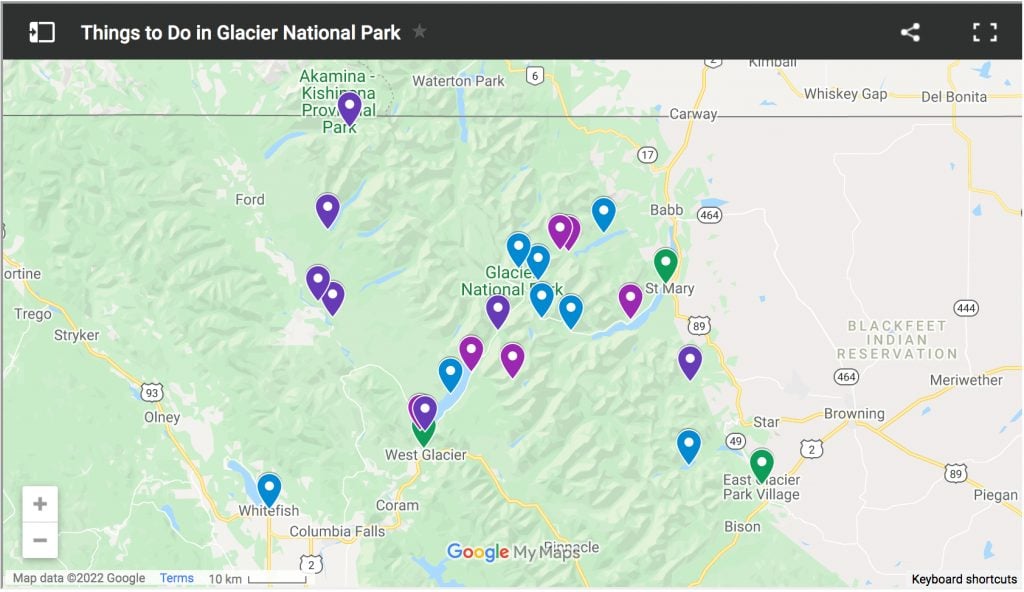
The map above displays the main entrances, campgrounds, lodging options, and locations for the best things to do in Glacier National Park.
Best time to visit Glacier National Park

Because the area is at high elevation and gets so much snow, many roads and trails in the park don’t open until July or even as late as early August. For example, the full GTTSR typically opens in late June or early July and the trail to Grinnell Glacier is often snow-covered until mid-July.
For many of the best things to do in Glacier National Park, we’d recommend visiting in late July, August, or early September to ensure that your options are not limited. This said, since there is such a short weather window, it is also the most busy time of the year.
Typically when trying to avoid crowds in popular destinations, I recommend going in the shoulder or off season. However, with Glacier, there is such a small window when weather is idea that it’s actually very difficult to see much of the park outside of the peak of summer.
In fact, our first visit to Glacier was at the beginning of October, and while the fall colors were starting to turn and there were no crowds to speak of, most of the roads were closed which meant we couldn’t see much of the park at all. Plus, it snowed while we were there, which made things even a little more challenging.
How to get to Glacier National Park

Glacier National Park is located in northwestern Montana, right on the Canadian border. Because the park is so massive, driving times vary drastically depending on which section of the park you are visiting.
The main entrance at West Glacier can be reached from:
- Whitefish, MT in 35 minutes
- Missoula, MT in 2 hours and 30 minutes
- Great Falls, MT in 3 hours 15 minutes
- Helena, MT in 4 hours
- West Entrance of Yellowstone in 6 hours and 30 minutes
- Grand Teton in 9 hours
The most popular entrance on the eastern side of the park is St. Mary’s, which provides access to the GTTSR.
The St. Mary’s entrance can be reached from:
- West Glacier in 1 hour 30 minutes
- Great Falls, MT in 2 hours and 30 minutes
- Missoula, MT in 4 hours and 30 minutes
- Helena, MT in 3 hours and 30 minutes
If you are arriving by plane, the closest airport is in Kalispell, Montana, located about 45 minutes from the West Glacier entrance and 2.5 hours from the St Mary Entrance. There is also an airport in Missoula, Montana, which may have better flight options but is further from the park, about 2.5 hours from the West Entrance and 4 hours from St. Mary.
Psst! Want to try out vanlife while visiting Glacier? If you don’t have the time for (or interest in) building your own conversion but you still want to give vanlife a test drive, we’ve got the info you need! We put together an entire guide to the best campervan rental companies in the US, including exclusive discounts for our readers!
Entrance tickets and fees
Entrance to Glacier National Park is $35 per vehicle and is good for seven days. Alternatively, you can purchase an America the Beautiful Pass for $80, which gives you access to all U.S. National Parks for an entire year. If you plan to visit more than 2 parks in a year, it almost certainly makes sense to purchase an annual pass.

Separate entrance tickets are also required for the GTTSR and the North Fork area. Tickets are in high demand and typically sell out immediately upon release, so make sure to plan ahead. We’ll tell you everything you need to know about getting GTTSR tickets below (internal link to item 1 on “things to do in Glacier” list).
Getting around in Glacier

To get around in Glacier National Park, you will need to either drive your own vehicle or rent a car. During the peak season, there is a park shuttle that runs the length of the GTTSR. That being said, it would be tough to get into the park or to any other section of the park without a vehicle of your own.
The park shuttle is mainly useful for avoiding parking trouble at some of the most crowded spots. You can read more about the GTTSR shuttle on the NPS website.
There is also a seasonal hiker’s shuttle operated by Glacier National Park Lodges that connects West Glacier, Apgar, Lake MacDonald Lodge, St. Mary and Many Glacier. Tickets for the hiker’s shuttle are first-come-first-serve, so we wouldn’t bank on it as a reliable form of transportation.
How long does it take to drive Going to the Sun Road?
Driving the full 50 miles of the GTTSR takes roughly 2 hours and will take you from the east side of the part to the west side (or vice versa).
However, we’d recommend giving yourself some buffer time for snow moving sections on the road as well as stops along the way.
Wanna give vanlife a try while visiting Glacier National Park?
It’s no secret we’re obsessed with #vanlife. However, if you don’t have the time (or interest!) in building your own conversion but you still want to give vanlife a test drive, we’ve got options for you…
Check out our list of top companies for USA Campervan Rentals from budget to bougie, we’ve even included some exclusive discounts for our readers.
One company we’d recommend looking into is Escape Campervans. They have 12 different locations across North America and come fully loaded with all the gear you need for an epic road trip. Plus, their rates are fair and affordable.
BONUS: We’ve partnered with them to give you a 10% off discount when you use our link!
Tips for visiting Glacier National Park

- Plan everything way earlier than you think you need to. That includes entrance tickets, campgrounds and lodging, backpacking permits, and tour reservations.
- Tickets are required to enter the Going to the Sun Road and North Fork section of the park. Check the NPS website well in advance of your trip for details on getting tickets.
- Beware that parking lots at popular areas and trailheads frequently fill up. Plan to get an early start or use the park shuttle to avoid parking issues. We arrived at Logan Pass at 7 a.m. to start the Highline Trail hike and were shocked to find people already circling the parking lot.
- Similarly, the NPS will limit access to entire areas of the park if they become overly congested. Again, we highly recommend starting your day as early as possible!
- Cell service in Glacier National Park is spotty in some areas and non-existent in others. Before you visit, download trail maps (we use AllTrails Pro) for the hikes you plan to do, download the offline version of Google Maps for this area, and be sure to grab a physical park map (remember those?!) to help you navigate.
- There are no gas stations inside the park, so fill up your tank before you hit the road!
How to escape the crowds at Glacier National Park
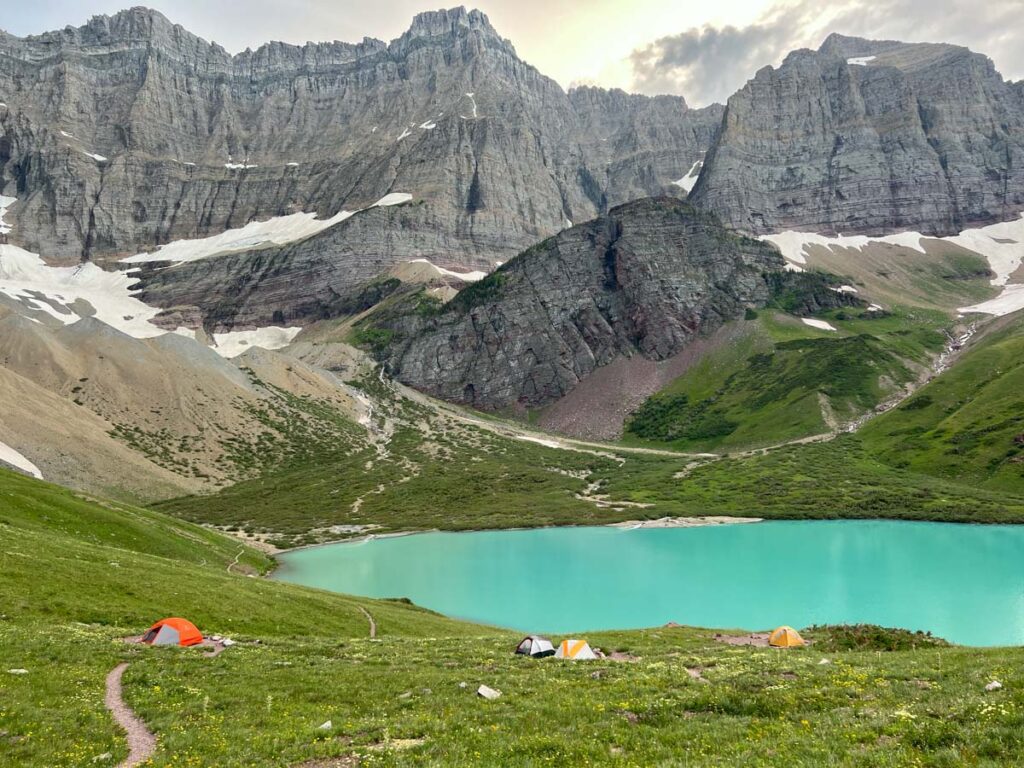
If you’re really anti-crowd (I feel ya), here are a few tips to help you avoid the masses).
a) Start your days early
Being that there is a very short window where all the roads are open in Glacier, most visitors come in a span of just a few months. If you, too, are visiting in the summer, chances are it will be busy any day of the week. Just like any destination, getting up early can help avoid the crowds that start to accumulate around 10 a.m.
Plan your days with the most popular attractions or hikes first so you have the best chance of getting there before most other visitors.
b) Get to the more remote parts of the park
While Glacier is an incredibly popular National Park, it is also huge! (Aka roughly 1 million acres!) Many visitors stick around the most popular areas — West Glacier and St. Mary’s — meaning that if you make it a point to get to the lesser-visited places, you’ll be able to get off the typical path. Just be prepared that some of these areas are harder to get to and have fewer facilities.
c) Go backcountry camping
Our very favorite way to escape crowds at even the most popular National Parks is to go backcountry camping (aka when you hike into your campsite with your tent and everything you need in your backpack). We’ve found that getting into the deep wilderness is a near guaranteed way to find solitude.
d) Explore these lesser-visited areas nearby
Glacier is amazing and well worth visiting. However, it’s not the only epic wilderness area in the region. In fact, there are 4 nearby parks wilderness areas that are absolutely incredible with just a fraction of the visitors that Glacier gets.
Here are our suggestions:
- Bob Marshall Wilderness
- Flathead National Forest
- Lolo National Forest
- Waterton Lake National Park (Canada)
Glacier National Park FAQs
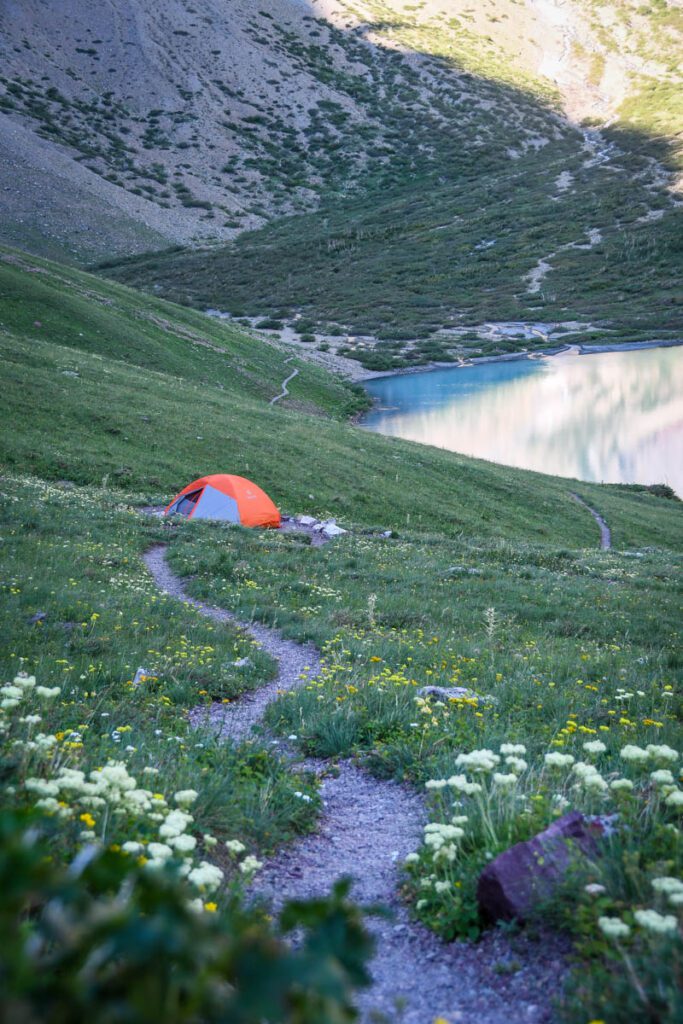
Still have questions about planning your trip to Glacier? We’ve got answers!
How many days do you need in Glacier?
The short answer? As many as possible!
There are endless things to do in Glacier National Park and you could easily spend a week here without scratching the surface.
More realistically, we’d say you need at least 2 full days to feel like you have truly experienced the park. 5-7 days would be our ideal recommendation. However, some people spend much longer in the park.
We met one person who was spending 7 days on one backpacking trip, so it all depends on how you want to spend your time.
Is Yellowstone or Glacier better?
This is a seriously subjective question and the answer you get will vary drastically based on who you ask.
If you’re looking for more epic hiking and truly incredibly mountain views, Glacier is where you’ll want to go. However, if you’re looking for wiser walks, viewpoints, and varied landscapes, Yellowstone may be more your style.
If you’re asking for my personal opinion on which is better, I would answer Glacier without hesitation. It feels less crowded an has better hiking opportunities (which is what we look for in National Parks).
If you have the time, why choose just one?! They are both national treasures, and aren’t all that far apart. Combined, they make an epic National Parks trip!
How far is Glacier to Yellowstone?
The distance will vary based on which side of Glacier NP you are coming from/going to, but you can expect the drive to take roughly 7 to 9 hours (without stopping).
If you have just 5 days and really want to see both parks, this itinerary will walk you through how to spend your time. If you have more days, you can see even more of these parks, or you could add in Grand Tetons too!
How many days do you need in Glacier?
The short answer? As many as possible! There are endless things to do in Glacier National Park and you could easily spend a week here without scratching the surface.
More realistically, we’d say you need at least 2 full days to feel like you have truly experienced the park and you’ll probably be ready to move on after 5-7 days, depending on your interests. We met one person who was spending 7 days on one backpacking trip, so it all depends on how you want to spend your time.
Where to stay in and near Glacier
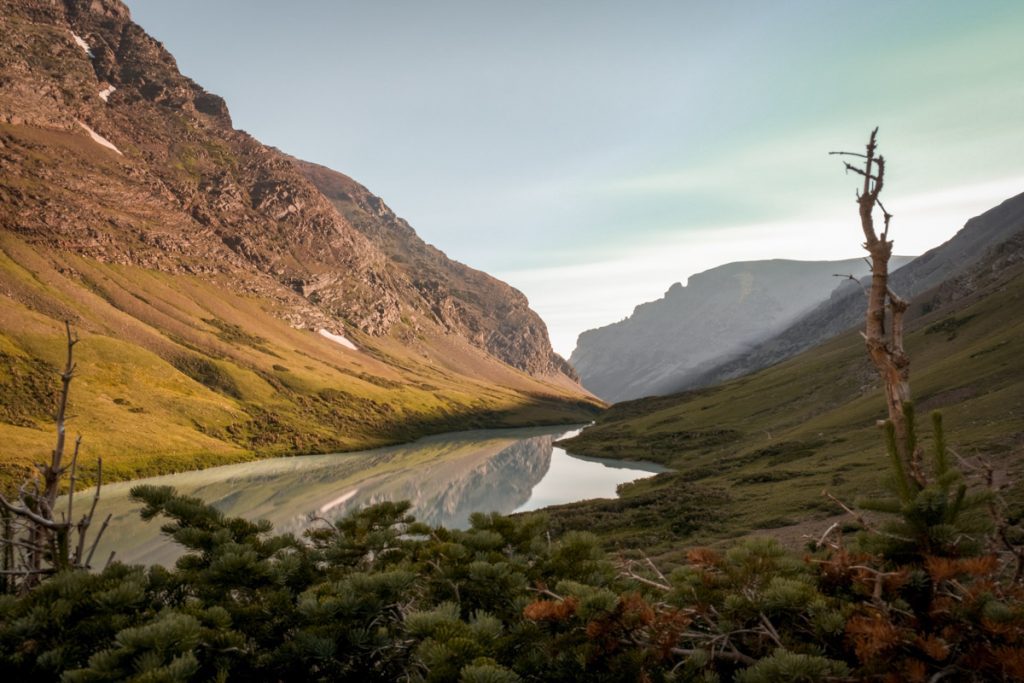
Since Glacier National Park is so large, there are many options for where to stay. The best choice depends on your budget, where you plan to spend the majority of your time, and unfortunately, what is available.
Lodging and campgrounds in and around Glacier book up months in advance during the peak season. We highly recommend you start trip planning at least 6 to 9 months in advance to avoid limiting your options.
Lodging inside Glacier National Park
There are several unique lodging options inside the park, but please note that staying in Glacier typically comes with a high price tag, especially during peak season. We’ve already highlighted the Granite Park Chalet, but below are a few other options that take a bit less effort to access (ie. you don’t need to hike):
- Many Glacier Hotel: The largest hotel in the park with an epic view looking over Swiftcurrent Lake, Many Glacier Hotel looks like it was plucked out of the Swiss countryside and plopped down in Montana. Staying here will cost you a pretty penny with prices for a double room in the $400 to $500 per night range during peak season.
- Swiftcurrent Motor Inn & Cabins: The nearby Swiftcurrent Motor Inn is a more budget-friendly option in the Many Glacier Area, with rates running around $200 per night.
- Lake McDonald Lodge: Located on the eastern shore of Lake McDonald, this rustic Swiss-style lodge is the perfect home base for exploring the Going-to-the-Sun Road.
- Village Inn at Apgar: Located just minutes from the West Entrance on Lake McDonald, the Village Inn offers suites with lake views and full kitchens.
- Rising Sun Motor Inn & Cabins: Located a few miles from the St. Mary entrance, the Rising Sun Motor Inn and Cabins offers more reasonably priced rooms in the $200 – $250 per night range.
- Sperry Chalet: A rustic mountain cabin, similar to the Granite Park Chalet, that is only accessible by trail but with the amenities you would expect from any hotel (linens, full restaurant, a warm bed, etc).
Whitefish
If a nice dinner and/or cold beer at a brewery sounds like the perfect way to end a busy day in Glacier, Whitefish is the place for you! Located about 35 minutes from the West Entrance, Whitefish is convenient for any activities on the western side of the park.
There are plenty of places to stay in Whitefish, such as these adorable modern cabins, the lovely Lodge at Whitefish Lake, or the more budget-friendly Chalet Motel.
Columbia Falls
The small town of Columbia Falls gets you even closer than Whitefish to the West Entrance of Glacier, making it a perfect place to stay if you plan to drive the GTTSR or visit Lake McDonald.
We loved our stay at “The Pines” and would highly recommend these cute, cozy and convenient cabins! Cedar Creek Lodge, operated by the same company as Many Glacier Hotel, is another great option in the heart of Columbia Falls.
East Glacier Park
If you plan to visit Two Medicine, East Glacier Park is the best place to stay, located about 25 minutes from the entrance. It’s also not a bad option for visiting Many Glacier or the St. Mary areas as well.
With a population of 388, this tiny, rustic town offers just a few lodging options, including the Jacobson’s Cottages, the Brownies Hostel (located over a bakery serving pastries and hot pizza!), and single-unit log cabins at Summit Mountain Lodge.
St. Mary
St. Mary is located on the east side of Glacier National Park, just a few minutes from the St. Mary entrance. It’s a great option if you plan to drive the GTTSR, hike the Highline Trail or visit the Many Glacier area.
While St. Mary isn’t much of a town, there is a grocery store and several lodging options. St. Mary Village is a great choice, offering a range of hotel rooms, several cabins, and cozy tiny homes.
Kalispell
As the largest major town (and by major we mean… a population of roughly 23k!) near Glacier, Kalispell will be the easiest place to find lodging.
That being said, it is located about 45 minutes south of the West Entrance, which puts you close to 3 hours from Many Glacier and over 2 hours from Two Medicine. Therefore, it’s a suitable option for exploring the GTTSR, but will involve more driving than staying in the park or one of the smaller towns nearby.
Note: Apgar and Sprague Creek can only be booked in advance starting in 2022, and the park expects to release reservations for the summer in late March or early April (exact dates have not been given).
The remaining 8 campgrounds are available on a first-come-first serve basis only. These campgrounds are also in high demand during peak season, making it tricky to snag a spot. Luckily, Glacier has a super helpful tool that displays historic fill times for each campground, giving you a sense for how early you need to arrive for the best shot at getting a site.
To be safe, we’d recommend arriving as early as possible and (respectfully) asking other campers who appear to be leaving if they’d be okay with you waiting for their spot while they pack up.
Campgrounds outside the park
Camping inside Glacier National Park is more convenient but, if you aren’t able to get a spot in the park, there are many campgrounds located around the park as well.
Whitefish has many RV parks and campgrounds, and property owners even rent out sections of their land for camping on Airbnb. There are also great campgrounds available around Flathead Lake, although staying there is a bit out of the way.
A Note about Camping: If you’re traveling in a campervan or simply hoping to save money on your visit to Glacier National Park by camping along the way, we have a deal for you!
The Dyrt is our favorite campsite locating app with the largest database of campgrounds (44,000+ campsites and counting!) and over 1 million user-submitted reviews. Plus, it’s super user-friendly, and has some pretty cool features, like outdoor gear contests and forums to connect and seek advice from fellow campers, that you won’t find on any other camping app.
Try their Pro Membership for FREE for 30 days and gain access to the offline version of the app, utilize their trip planning feature AND get exclusive discounts on campsites and gear!

Dispersed camping
Free dispersed camping is available in the Flathead National Forest. While this can be a good backup option if you aren’t able to secure a campsite inside the park, we wouldn’t recommend it due to the amount of driving it would entail.
We’re typically big fans of dispersed camping, but Glacier is so big that the small amount of money you would save is not worth the logistical challenge.
You can find more information about dispersed camping in Flathead National Forest here.
What to pack for visiting Glacier National Park

- Warm layers: Even in the middle of summer, mornings and evenings in Glacier can get chilly! We recommend packing layers and a warm jacket.
- Rain jacket or windbreaker: Winds in Glacier can be brutal (especially along the Highline Trail), so you’ll want a jacket to break the wind.
- Bear spray: This is grizzly country! If you plan to hike, each person in your group should carry their own can of bear spray in a readily accessible spot (odds are you won’t need it, but in the unlikely event that you do, it does no good in your backpack!).
- Hydration pack and/or water bottle: A must on any outdoor adventure
- Hiking boots: A pair of boots with good traction are important if you plan to hike, as many of the trails are steep and rocky.
- Microspikes: If visiting earlier in the fall or early summer, the trails are likely to be snow or ice-covered at higher elevations.
- Bathing suit and towel: If you decide you want to take us up on that dip into a freezing alpine lake, be sure to pack a bathing suit and means of drying off.
Round up of the best things to do in Glacier National Park
Here’s a recap of all the best things to do in Glacier so you can see everything in one place.
- Going-to-the-Sun Road
- Go hiking
- Wild Goose Island
- Kayak (or SUP) to a hidden lake
- Huckleberry ice cream
- Visit Many Glacier
- Whitewater rafting
- Swim in a glacial lake
- Stargazing
- Huckleberry cocktail at St. Mary’s Lodge
- Spot wildlife
- Catch sunrise at Two Medicine Lake
- Go on a backpacking trip
- See the colorful pebbles at Lake McDonald
- Red Bus Tour
- See a glacier
- Explore Glacier’s historic lodges
- Waterton Lake National Park
- Fly fishing
- Horseback riding
- Spend a night at Granite Park Chalet
- Hang out at the lakes
- Go glamping
- Visit Whitefish, Montana
- Beer at Bonsai Brewing Project

About the co-authors
This article was co-written by Katie (Two Wandering Soles) and Sarah and Matt from Two Outliers.
Sarah and Matt are two digital nomads, outdoor enthusiasts, and the creators of Two Outliers, an adventure travel and photography blog dedicated to helping you plan your next adventure! They road trip full-time across the United States along with their cat, Fitzgerald, while working full time and spending all their free time hiking, camping, backpacking, and exploring new places. They hope their experiences will inspire others to be outliers too!
Love exploring USA National Parks?
Us too—in fact, we’re kind of obsessed with them!
We have tons of articles, guides, and itineraries for just about every national park we’ve visited. Browse our USA National Parks homepage or click on one of our national park guides below.
- Acadia National Park, ME
- Arches National Park, UT
- Bryce Canyon National Park, UT
- Canyonlands National Park, UT
- Capitol Reef National Park, UT
- Death Valley National Park, CA & NV
- Grand Teton National Park, WY
- Joshua Tree National Park, CA
- North Cascades National Park, WA
- Olympic National Park, WA
- Rocky Mountain National Park, CO
- Yellowstone National Park, WY
- Yosemite National Park, CA
- Zion National Park, UT
Save this article on Pinterest for later!


We want to hear from you
Have you been to Glacier National Park? Questions about visiting the park? What would you add to our list of amazing things to do in Glacier National Park? Let us know in the comments section below.
